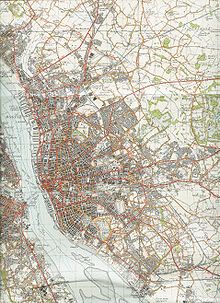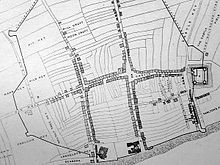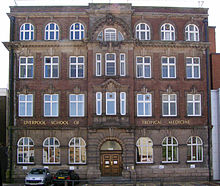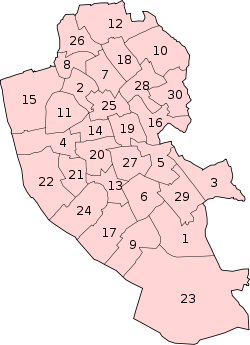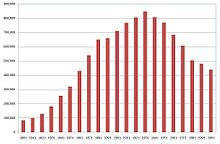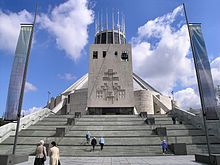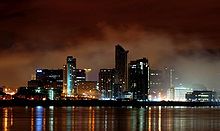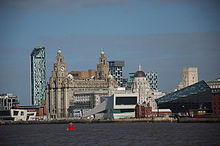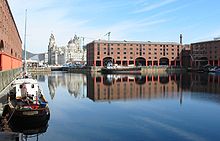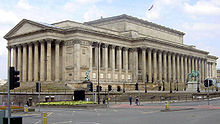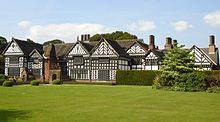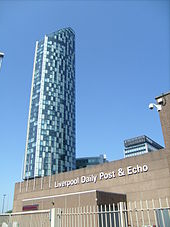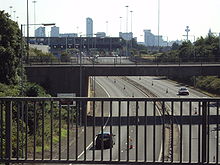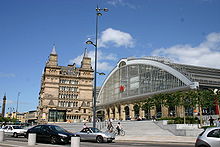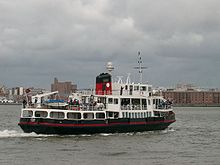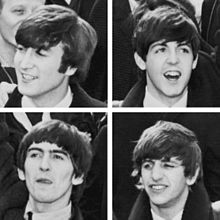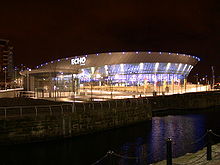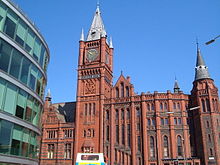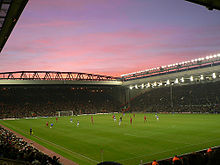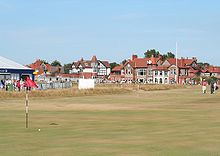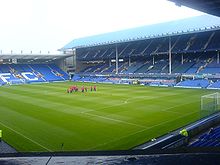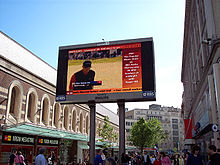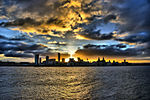- Liverpool
-
This article is about the city. For the football club, see Liverpool F.C.. For other uses, see Liverpool (disambiguation).
Liverpool — Metropolitan borough and City — Clockwise from the upper left: the Cavern Club, the Three Graces of the Pier Head (the Liver Building, Cunard Building and Port of Liverpool Building), the skyline of Liverpool's commercial district, the Albert Dock and St George's Hall 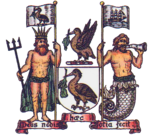
Coat of arms of Liverpool City CouncilNickname(s): The Pool, The World In One City[1] Location within England
Coordinates: 53°24′N 2°59′W / 53.4°N 2.983°W Sovereign state United Kingdom Constituent country England Region North West England Ceremonial county Merseyside Admin HQ Liverpool City Centre Founded 1207 City Status 1880 Government – Type Metropolitan borough, City – Governing body Liverpool City Council – Leadership: Leader & Cabinet – Executive: Labour – Leader of the City Council Cllr Joe Anderson (Lab) – MPs: Steve Rotherham (Lab),
Stephen Twigg (Lab),
Louise Ellman (Lab),
Luciana Berger (Lab),
Maria Eagle (Lab)Area – Metropolitan borough and City 43.2 sq mi (111.84 km2) Elevation 230 ft (70 m) Population (2007 est / Urban=2006) – Metropolitan borough and City 445,200 (Ranked 9th) – Density 10,072.5/sq mi (3,889/km2) – Urban 816,900 – Metro 1,103,089 – Ethnicity
(June 2009 estimates)[2]Ethnic groupsTime zone Greenwich Mean Time (UTC+0) – Summer (DST) British Summer Time (UTC+1) Postal Code L postcode area Area code(s) 0151 ISO 3166-2 GB-LIV ONS code 00BY OS grid reference SJ3490 NUTS 3 UKD52 Demonym Scouser/Liverpudlian Website http://www.liverpool.gov.uk/ Liverpool (
 /ˈlɪvəpuːl/) is a city and metropolitan borough of Merseyside, England, along the eastern side of the Mersey Estuary. It was founded as a borough in 1207 and was granted city status in 1880. As of 2001 Liverpool had a population of 435,500, and lies at the centre of the wider Liverpool Urban Area, which had a population of 816,216.[3]
/ˈlɪvəpuːl/) is a city and metropolitan borough of Merseyside, England, along the eastern side of the Mersey Estuary. It was founded as a borough in 1207 and was granted city status in 1880. As of 2001 Liverpool had a population of 435,500, and lies at the centre of the wider Liverpool Urban Area, which had a population of 816,216.[3]Historically a part of Lancashire, the urbanisation and expansion of Liverpool were both largely brought about by the city's status as a major port. By the 18th century, trade from the West Indies, Ireland and mainland Europe coupled with close links with the Atlantic Slave Trade furthered the economic expansion of Liverpool. By the early 19th century, 40% of the world's trade passed through Liverpool's docks, contributing to Liverpool's rise as a major city.
Inhabitants of Liverpool are referred to as Liverpudlians but are also colloquially known as "Scousers", in reference to the local dish known as "scouse", a form of stew. The word "Scouse" has also become synonymous with the Liverpool accent and dialect.[4] Liverpool's status as a port city has contributed to its diverse population, which, historically, were drawn from a wide range of peoples, cultures, and religions, particularly those from Ireland. The city is also home to the oldest Black African community in the country and the oldest Chinese community in Europe.
The popularity of The Beatles, Gerry and the Pacemakers and the other groups from the Merseybeat era contributes to Liverpool's status as a tourist destination; tourism forms a significant part of the city's modern economy. The city celebrated its 800th anniversary in 2007, and it held the European Capital of Culture title together with Stavanger, Norway, in 2008.[5]
Several areas of the city centre were granted World Heritage Site status by UNESCO in 2004. Referred to as the Liverpool Maritime Mercantile City, the site comprises six separate locations in the city including the Pier Head, Albert Dock and William Brown Street and includes many of the city's most famous landmarks.[6]
Liverpool is also the home of two Premier League football clubs, Liverpool F.C. and Everton F.C.. Matches between the two clubs are known as the Merseyside derby. Both clubs have had a successful record throughout history, both in results and in producing England players born in the city. Liverpool F.C. is also the English club with the most European titles.
Contents
History
Main article: History of LiverpoolKing John's letters patent of 1207 announced the foundation of the borough of Liverpool, but by the middle of the 16th century the population was still only around 500. The original street plan of Liverpool is said to have been designed by King John near the same time it was granted a royal charter, making it a borough. The original seven streets were laid out in a H shape:
- Bank Street (now Water Street)
- Castle Street
- Chapel Street
- Dale Street
- Juggler Street (now High Street)
- Moor Street (now Tithebarn Street)
- Whiteacre Street (now Old Hall Street)
In the 17th century there was slow progress in trade and population growth. Battles for the town were waged during the English Civil War, including an eighteen-day siege in 1644. In 1699 Liverpool was made a parish by Act of Parliament, that same year its first slave ship, Liverpool Merchant, set sail for Africa. As trade from the West Indies surpassed that of Ireland and Europe, and as the River Dee silted up, Liverpool began to grow. The first commercial wet dock was built in Liverpool in 1715.[7][8] Substantial profits from the slave trade helped the town to prosper and rapidly grow. By the close of the century Liverpool controlled over 41% of Europe's and 80% of Britain's slave commerce.
In the early 19th century Liverpool played a major role in the Antarctic sealing industry, in recognition of which Liverpool Beach in the South Shetland Islands is named after the city.[9]
By the start of the 19th century, 40% of the world's trade was passing through Liverpool and the construction of major buildings reflected this wealth. In 1830, Liverpool and Manchester became the first cities to have an intercity rail link, through the Liverpool and Manchester Railway. The population continued to rise rapidly, especially during the 1840s when Irish migrants began arriving by the hundreds of thousands as a result of the Great Famine. By 1851, approximately 25% of the city's population was Irish-born. During the first part of the 20th century, Liverpool was drawing immigrants from across Europe.
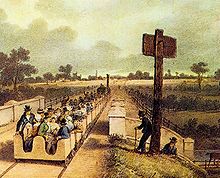 Inaugural journey of the Liverpool and Manchester Railway in 1830, the first ever commercial railway line.
Inaugural journey of the Liverpool and Manchester Railway in 1830, the first ever commercial railway line.
20th century
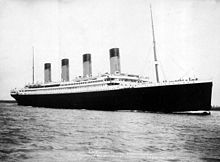 Liverpool was the port of registry of the ill fated ocean liner, the RMS Titanic. The words Titanic, Liverpool could be seen on the stern of the ship that sank in April 1912 with the loss of 1,517 lives (including numerous Liverpudlians). A Memorial to the Engine Room Heroes of the Titanic is located on the city's waterfront.
Liverpool was the port of registry of the ill fated ocean liner, the RMS Titanic. The words Titanic, Liverpool could be seen on the stern of the ship that sank in April 1912 with the loss of 1,517 lives (including numerous Liverpudlians). A Memorial to the Engine Room Heroes of the Titanic is located on the city's waterfront.
The Housing Act 1919 resulted in mass council housing building across Liverpool during the 1920s and 1930s. Thousands of families were rehoused from the inner-city to new suburban housing estates, based on the pretext that this would improve their standard of living, though this is largely subjective. A large number of private homes were also built during this era. The process continued after the Second World War, with many more new housing estates being built in suburban areas, while some of the older inner city areas were also redeveloped for new homes.
The Great Depression of the early 1930s saw unemployment in the city peak at around 30%.
During the Second World War there were 80 air-raids on Merseyside, killing 2,500 people and causing damage to almost half the homes in the metropolitan area. Significant rebuilding followed the war, including massive housing estates and the Seaforth Dock, the largest dock project in Britain. Much of the immediate reconstruction of the city centre has been deeply unpopular, and was as flawed as much town planning renewal in the 1950s and 1960s – the portions of the city's heritage that survived German bombing could not withstand the efforts of urban renewal. Since 1952 Liverpool has been twinned with Cologne, Germany, a city which also experienced severe aerial bombing during the war.
Like most British cities and industrialised towns, Liverpool became home to a significant number of Commonwealth immigrants after World War II, mostly settling in older inner city areas such as Toxteth. However, a significant West Indian black community had existed in the city as long ago as the first two decades of the 20th century. In 1919, the city was the scene of one of Britain's first - if not the very first - race riot when local white people took part in violent protests against the city's black residents. A black man was killed by a lynch mob in the city that year.[10]
In the 1960s Liverpool was the centre of the "Merseybeat" sound which became synonymous with The Beatles and fellow Liverpudlian rock bands.
From the mid-1970s onwards Liverpool's docks and traditional manufacturing industries went into sharp decline. The advent of containerisation meant that the city's docks became largely obsolete. By the early 1980s unemployment rates in Liverpool were once again among the highest in the UK.[11]
In recent years, Liverpool's economy has recovered and has experienced growth rates higher than the national average since the mid-nineties.
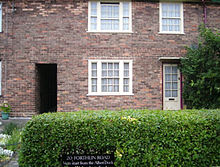 20 Forthlin Road is one of many tourist attractions related to The Beatles.
20 Forthlin Road is one of many tourist attractions related to The Beatles.
Previously part of Lancashire, and a county borough from 1889, Liverpool became in 1974 a metropolitan borough within the newly created metropolitan county of Merseyside.
At the end of the 20th century Liverpool was concentrating on regeneration, a process which still continues today.
21st century
To celebrate the Golden Jubilee of Elizabeth II in 2002, the conservation charity Plantlife organised a competition to choose county flowers; the sea-holly was Liverpool's final choice.
Capitalising on the popularity of 1960s rock groups, such as The Beatles, as well as the city's world-class art galleries, museums and landmarks, tourism has also become a significant factor in Liverpool's economy.
In 2004, property developer Grosvenor started the Paradise Project, a £920 m development centred on Paradise Street, which involved the most significant changes to Liverpool's city centre since the post-war reconstruction. Renamed 'Liverpool 1', the centre opened in May 2008.
In 2007, the city celebrated the 800th anniversary of the foundation of the borough of Liverpool, for which a number of events were planned. Liverpool is a joint European Capital of Culture for 2008. The main celebrations, in September 2008, included La Princesse, a large mechanical spider which is 20 metres high and weighs 37 tonnes, and represents the "eight legs" of Liverpool: honour, history, music, the Mersey, the ports, governance, sunshine and culture. La Princesse roamed the streets of the city during the festivities, and concluded by entering the Queensway Tunnel.
Second city of Empire
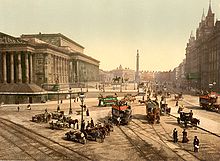 Lime Street, Liverpool in the 1890s, St.George's Hall to the left, Great North Western Hotel to the right, Walker Art Gallery and Sessions House in the background. Statues of Prince Albert, Disraeli, Queen Victoria and Wellington's Column in the middle ground.
Lime Street, Liverpool in the 1890s, St.George's Hall to the left, Great North Western Hotel to the right, Walker Art Gallery and Sessions House in the background. Statues of Prince Albert, Disraeli, Queen Victoria and Wellington's Column in the middle ground.
For periods during the 19th century the wealth of Liverpool exceeded that of London itself,[12] and Liverpool's Custom House was the single largest contributor to the British Exchequer.[13] Liverpool's status can be judged from the fact that it was the only British city ever to have its own Whitehall office.[14]
The first United States consul anywhere in the world, James Maury, was appointed to Liverpool in 1790, and remained in office for 39 years.
As early as 1851 the city was described as "the New York of Europe"[15] and its buildings, constructed on a heroic, even megalomaniacal scale stand witness to the supreme confidence and ambition of the city at the turn of the 20th century.
Liverpool was also the site of the UK's first provincial airport, operating from 1930.
Elgar's Pomp and Circumstance March No.1, often seen as Britain's Imperial anthem, was dedicated by the composer to the Liverpool Orchestral Society and had its premiere in the city in October 1901.
During the Second World War, the critical strategic importance of Liverpool was recognised by both Hitler and Churchill, with the city suffering a blitz second only to London's,[16] and the pivotal Battle of the Atlantic being planned, fought and won from Liverpool.[17]
Inventions and innovations
School of Tropical Medicine, the first in the world
Ferries, railways, transatlantic steamships, municipal trams,[18] electric trains[19] and the helicopter[20] were all pioneered in Liverpool as modes of mass transit. In 1829 and 1836 the first underground railway tunnels in the world were constructed under Liverpool.[21]
The first School for the Blind,[22] High School for Girls,[23][24] council house[25] and Juvenile Court[26] were all founded in Liverpool. The RSPCA,[27] NSPCC,[28] Age Concern,[29] Relate, Citizen's Advice Bureau[30] and Legal Aid all evolved from work in the city.
In the field of public health, the first lifeboat station, public baths and wash-houses,[31] sanitary act,[32] medical officer for health, district nurse, slum clearance,[33] purpose-built ambulance,[34] X-ray medical diagnosis,[35] school of tropical medicine, motorised municipal fire-engine,[36] free school milk and school meals,[37] cancer research centre,[38] and zoonosis research centre[39] all originated in Liverpool. The first British Nobel Prize was awarded in 1902 to Ronald Ross, professor at the School of Tropical Medicine, the first school of its kind in the world.[40] Orthopaedic surgery was pioneered in Liverpool by Hugh Owen Thomas,[41] and modern medical anaesthetics by Thomas Cecil Gray.
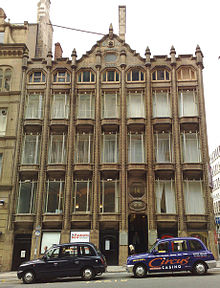 Oriel Chambers, the first 'modern' building in the world
Oriel Chambers, the first 'modern' building in the world
In finance, Liverpool founded the UK's first Underwriters' Association[42] and the first Institute of Accountants. The Western world's first financial derivatives (cotton futures) were traded on the Liverpool Cotton Exchange in the late 1700s.[43]
In the arts, Liverpool was home to the first lending library, athenaeum society, arts centre[44] and public art conservation centre.[45] Liverpool is also home to the UK's oldest surviving classical orchestra, the Royal Liverpool Philharmonic Orchestra.[46]
In 1864, Peter Ellis built the world's first iron-framed, curtain-walled office building, Oriel Chambers, the prototype of the skyscraper.
Between 1862 and 1867, Liverpool held an annual Grand Olympic Festival. Devised by John Hulley and Charles Melly, these games were the first to be wholly amateur in nature and international in outlook.[47][48] The programme of the first modern Olympiad in Athens in 1896 was almost identical to that of the Liverpool Olympics.[49] In 1865 Hulley co-founded the National Olympian Association in Liverpool, a forerunner of the British Olympic Association. Its articles of foundation provided the framework for the International Olympic Charter.
Shipowner Sir Alfred Lewis Jones introduced the banana to Great Britain in 1884.[50]
In 1897, the Lumière brothers filmed Liverpool,[51] including what is believed to be the world's first tracking shot,[52] taken from the Liverpool Overhead Railway – the world's first elevated electrified railway.
Liverpool inventor Frank Hornby was a visionary in toy development and manufacture and produced three of the most popular lines of toys in the 20th century: Meccano, Hornby Model Railways and Dinky Toys.
In 1999, Liverpool was the first city outside the capital to be awarded blue plaques by English Heritage in recognition of the "significant contribution made by its sons and daughters in all walks of life."[53]
Government
Liverpool has three tiers of government; the Local Council, the National Government and the European Parliament. Liverpool is officially governed by a Unitary Authority, as when Merseyside County Council was disbanded civic functions were returned to a district borough level. However several services such as the Police and Fire and Rescue Service, continue to be run at a county-wide level.
Local council
See also: Liverpool City Council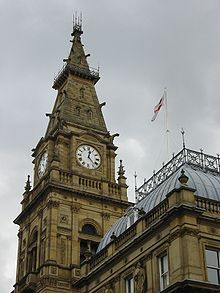 A number of Liverpool City Council services are based in the Municipal Buildings
A number of Liverpool City Council services are based in the Municipal Buildings
The City of Liverpool is governed by Liverpool City Council, and is one of five metropolitan boroughs that combine to make up the metropolitan county of Merseyside. The council consists of 90 elected councillors who represent local communities throughout the city,[54] as well as a five man executive management team who are responsible for the day to day running of the council.[55] Part of the responsibility of the councillors is the election of a council leader and Lord Mayor. The council leader's responsibility is to provide directionality for the council as well as acting as medium between the local council, central government and private & public partners.[56] The Lord Mayor acts as the 'first citizen' of the city and is responsible for promoting the city, supporting local charities & community groups as well as representing the city at civic events[57] The current council leader is Joe Anderson, and current Lord Mayor is Councillor Mike Storey.[58]
For local elections the city is split into 30 local council wards,[59] which in alphabetical order are:
- Allerton & Hunts Cross
- Anfield
- Belle Vale
- Central
- Childwall
- Church
- Clubmoor
- County
- Cressington
- Croxteth
- Everton
- Fazakerley
- Greenbank
- Kensington & Fairfield
- Kirkdale
- Knotty Ash
- Mossley Hill
- Norris Green
- Old Swan
- Picton
- Princes Park
- Riverside
- Speke Garston
- St Michaels
- Tuebrook & Stoneycroft
- Warbreck
- Wavertree
- West Derby
- Woolton
- Yew Tree
During the most recent local elections, held in May 2011, the Labour Party consolidated its control of Liverpool City Council, following on from regaining power for the first time in 12 years, during the previous elections in May 2010.[60] The Labour Party gained 11 seats during the election, taking their total to 62 seats, compared with the 22 held by the Liberal Democrats. Of the remaining seats the Liberal Party won three and the Green Party claimed two. The Conservative Party, one of the three major political parties in the UK had no representation on Liverpool City Council.[60][61]
In February 2008, Liverpool City Council was revealed to be the worst-performing council in the country, receiving just a one star rating (classified as inadequate). The main cause of the poor rating was attributed to the council's poor handling of tax-payer money, including the accumulation of a £20m shortfall on Capital of Culture funding.[62]
While Liverpool through most of the 19th and early 20th Century was a municipal stronghold of Toryism, support for the Conservative Party recently has been among the lowest in any part of Britain, particularly since the monetarist economic policies of prime minister Margaret Thatcher after her 1979 general election victory contributed to high unemployment in the city which did not begin to fall for many years.[63] Liverpool is one of the Labour Party's key strongholds; however the city has seen hard times under Labour governments as well, particularly in the Winter of Discontent (late 1978 and early 1979) when Liverpool suffered public sector strikes along with the rest of the United Kingdom but also suffered the particularly humiliating misfortune of having grave-diggers going on strike, leaving the dead unburied.[64]
Parliamentary constituencies and MPs
Liverpool has four parliamentary constituencies entirely within the city, through which Members of Parliament (MPs) are elected to represent the city in Westminster: Liverpool Riverside, Liverpool Walton, Liverpool Wavertree and Liverpool West Derby.[65] At the last general election, all were won by Labour with representation being from Louise Ellman, Steve Rotheram, Luciana Berger and Stephen Twigg respectively. Due to boundary changes prior to the 2010 election, the Liverpool Garston constituency was merged with most of Knowsley South to form the Garston and Halewood cross-boundary seat. At the most recent election this seat was won by Maria Eagle of the Labour Party.[66]
Geography
Liverpool has been described as having "the most splendid setting of any English city."[67] At 53°24′0″N 2°59′0″W / 53.4°N 2.983333°W (53.4, −2.98), 176 miles (283 km) northwest of London, located on the Liverpool Bay of the Irish Sea the city of Liverpool is built across a ridge of sandstone hills rising up to a height of around 230 feet (70 m) above sea-level at Everton Hill, which represents the southern boundary of the West Lancashire Coastal Plain.
The Mersey Estuary separates Liverpool from Birkenhead, Wallasey and the Kirby sands to the south west. The boundaries of Liverpool are adjacent to Bootle, Crosby and Maghull in south Sefton to the north, and Kirkby, Huyton, Prescot and Halewood in Knowsley to the east.
Climate
Liverpool experiences a temperate maritime climate, like much of the British Isles, with relatively cool summers and mild winters. Its coastal location and urban situation means diurnal temperature ranges are particularly subdued, ranging from an average of 7.0 °C in May to just 3.8 °C during December. Historically, Bidston Observatory (actually located on the Wirral Peninsula) has provided the longest and most unbroken weather data for the Merseyside area. More recently, the Met Office has operated a weather station at Crosby.
The absolute minimum temperature recorded at Bidston was −12.8 °C (9.0 °F) during January 1881, typically the coldest night of the year should fall to −4 °C (24.8 °F) (1971–2000 average) However, the variability of the local climate was exposed as the weather station at Crosby fell to −17.6 °C (0.3 °F)[68] during December 2010.
The absolute maximum temperature recorded at Bidston was 34.5 °C (94.1 °F) in August 1990 - typically the warmest day of the year should reach 27.5 °C (81.5 °F) (1971–2000 average). The absolute maximum at Crosby is 33.5 °C (92.3 °F), recorded in July 2006.[69]
Climate data for Bidston Observatory, elevation 7m, Temp averages 1976–2002, Rain & Sun averages 1971–2000, extremes 1867–2002 Month Jan Feb Mar Apr May Jun Jul Aug Sep Oct Nov Dec Year Record high °C (°F) 14.7
(58.5)16.6
(61.9)21.2
(70.2)25.3
(77.5)28.1
(82.6)30.7
(87.3)31.6
(88.9)34.5
(94.1)30.4
(86.7)24.6
(76.3)17.8
(64.0)15.8
(60.4)34.5
(94.1)Average high °C (°F) 6.8
(44.2)7.2
(45.0)9.2
(48.6)11.5
(52.7)15.3
(59.5)17.3
(63.1)19.2
(66.6)19.3
(66.7)16.6
(61.9)13.1
(55.6)9.6
(49.3)7.4
(45.3)12.71
(54.87)Average low °C (°F) 2.6
(36.7)2.6
(36.7)4.1
(39.4)5.4
(41.7)8.3
(46.9)10.9
(51.6)13.1
(55.6)13.1
(55.6)11.2
(52.2)8.5
(47.3)5.6
(42.1)3.6
(38.5)7.42
(45.35)Record low °C (°F) −12.8
(9.0)−11.3
(11.7)−7.5
(18.5)−5
(23)0.0
(32.0)3.4
(38.1)6.6
(43.9)5.2
(41.4)3.7
(38.7)−2.9
(26.8)−5.3
(22.5)−10.7
(12.7)−12.8
(9.0)Precipitation mm (inches) 61.65
(2.4272)48.91
(1.9256)51.86
(2.0417)43.86
(1.7268)50.83
(2.0012)63.07
(2.4831)46.08
(1.8142)59.25
(2.3327)61.50
(2.4213)60.58
(2.385)60.34
(2.3756)68.82
(2.7094)684.37
(26.9437)Sunshine hours 56.0 70.3 105.1 154.2 207.0 191.5 197.0 175.2 132.7 97.3 65.8 46.8 1,499.1 Source: National Oceanography Centre [70] Climate data for Liverpool Month Jan Feb Mar Apr May Jun Jul Aug Sep Oct Nov Dec Year Record high °C (°F) 13
(57)15
(59)17
(64)26
(79)27
(82)32
(90)32
(91)33
(93)27
(82)23
(75)16
(61)15
(59)33
(93)Average high °C (°F) 6.6
(43.9)6.6
(43.9)9.4
(48.9)11.6
(52.9)15.5
(59.9)17.7
(63.9)20
(68)19.4
(66.9)16.6
(61.9)12.7
(54.9)9.4
(48.9)7.7
(45.9)12.7 Daily mean °C (°F) 5
(41)4
(39)7
(45)8
(46)12
(54)14
(57)17
(63)16
(61)14
(57)11
(52)7
(45)6
(43)10 Average low °C (°F) 2.2
(36.0)2.2
(36.0)3.3
(37.9)4.4
(39.9)7.2
(45.0)10.5
(50.9)12.7
(54.9)12.2
(54.0)10
(50)7.2
(45.0)4.4
(39.9)3.3
(37.9)6.6 Record low °C (°F) −10
(14)−7
(19)−6
(21)−2
(27)0
(32)0
(32)7
(45)5
(41)0
(32)−2
(27)−5
(23)−13
(9)−13
(9)Rainfall mm (inches) 97
(3.82)94
(3.7)101
(3.98)85
(3.35)68
(2.68)71
(2.8)40
(1.57)55
(2.17)44
(1.73)61
(2.4)78
(3.07)65
(2.56)859
(33.82)Avg. precipitation days 25 22 26 23 22 22 23 23 24 24 23 25 282 Avg. snowy days 6 5 4 2 0 0 0 0 0 0 1 4 22 Sunshine hours 62 56 124 150 186 210 186 155 129 93 60 31 1,442 Source: [71]
Rainfall:[72]
Sunshine:[73]Green Liverpool
In 2010 Liverpool City Council and the Primary Care Trust Commissioned The Mersey Forest to complete A Green Infrastructure Strategy for the City.[74]
Demography
Main article: Demography of Liverpool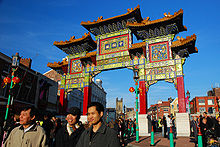 The ornamental gate to Chinatown, Liverpool
The ornamental gate to Chinatown, Liverpool
As with other major British cities, Liverpool has a large and diverse population. At the 2001 UK Census the recorded population of Liverpool was 441,900,[75] while a mid-2008 estimate by the Office for National Statistics had the city's population as 434,900.[76] Liverpool's population peaked in 1930s with 846,101 recorded in the 1931 census.[77] Since then the city has experienced negative population growth every decade, with at its peak over 100,000 people leaving the city between 1971 and 1981.[78] Between 2001 and 2006 it experienced the ninth largest percentage population loss of any UK unitary authority.[79] The "Liverpool city region", as defined by the Mersey Partnership, includes Wirral, Warrington, Flintshire, Chester and other areas, and has a population of around 2 million.[80]
In common with many cities, Liverpool's population is younger than that of England as a whole, with 42.3 per cent of its population under the age of 30, compared to an English average of 37.4 per cent.[81] 65.1 per cent of the population is of working age.[81]
Ethnicity
As of June 2009, an estimated 91.0 per cent of Liverpool's population was White, 3.0 per cent Asian or Asian British, 1.9 per cent Black or Black British, 2.0 per cent mixed-race and 2.1 per cent Chinese and other.[2]
Liverpool is home to Britain's oldest Black community, dating to at least the 1730s, and some Black Liverpudlians are able to trace their ancestors in the city back ten generations.[82] Early Black settlers in the city included seamen, the children of traders sent to be educated, and freed slaves, since slaves entering the country after 1722 were deemed free men.[83]
The city is also home to the oldest Chinese community in Europe; the first residents of the city's Chinatown arrived as seamen in the 19th century.[84] The gateway in Chinatown, Liverpool is also the largest gateway outside of China. The city is also known for its large Irish population and its historical Welsh population.[85] In 1813, 10 per cent of Liverpool's population was Welsh, leading to the city becoming known as "the capital of North Wales".[85] Following the start of the Great Irish Famine, two million Irish people migrated to Liverpool in the space of one decade, many of them subsequently departing for the United States.[86] By 1851, more than 20 per cent of the population of Liverpool was Irish.[87] At the 2001 Census, 1.17 per cent of the population were Welsh-born and 0.75 per cent were born in the Republic of Ireland, while 0.54 per cent were born in Northern Ireland,[88] but many more Liverpudlians are of Welsh[citation needed] or Irish ancestry.
Religion
 The Al-Rahma Mosque in the Toxteth area of Liverpool
The Al-Rahma Mosque in the Toxteth area of Liverpool
The thousands of migrants and sailors passing through Liverpool resulted in a religious diversity that is still apparent today. This is reflected in the equally diverse collection of religious buildings,[89] and two Christian cathedrals.
Christ Church, in Buckingham Road, Tuebrook, is a conservative evangelical congregation and is affiliated with the Evangelical Connexion.[90] They worship using the 1785 Prayer Book, and regard the Bible as the sole rule of faith and practice.
The parish church of Liverpool is the Anglican Our Lady and St Nicholas, colloquially known as "the sailors church", which has existed near the waterfront since 1257. It regularly plays host to Catholic masses. Other notable churches include the Greek Orthodox Church of St Nicholas (built in the Neo-Byzantine architecture style), and the Gustav Adolfus Kyrka (the Swedish Seamen's Church, reminiscent of Nordic styles).
Liverpool's wealth as a port city enabled the construction of two enormous cathedrals, both dating from the 20th century. The Anglican Cathedral, which was designed by Sir Giles Gilbert Scott and plays host to the annual Liverpool Shakespeare Festival, has one of the longest naves, largest organs and heaviest and highest peals of bells in the world. The Roman Catholic Metropolitan Cathedral, on Mount Pleasant next to Liverpool Science Park was initially planned to be even larger. Of Sir Edwin Lutyens' original design, only the crypt was completed. The cathedral was eventually built to a simpler design by Sir Frederick Gibberd; while this is on a smaller scale than Lutyens' original design, it still manages to incorporate the largest panel of stained glass in the world. The road running between the two cathedrals is called Hope Street, a coincidence which pleases believers. The cathedral is colloquially referred to as "Paddy's Wigwam" due to its shape.[91][92]
Liverpool contains several synagogues, of which the Grade I listed Moorish Revival Princes Road Synagogue is architecturally the most notable. Princes Road is widely considered to be the most magnificent of Britain's Moorish Revival synagogues and one of the finest buildings in Liverpool.[93] Liverpool has a thriving Jewish community with a further two orthodox Synagogues, one in the Allerton district of the city and a second in the Childwall district of the city where a significant Jewish community reside. A third orthodox Synagogue in the Greenbank Park area of L17 has recently closed, and is a listed 1930s structure. There is also a Lubavitch Chabad House and a reform Synagogue. Liverpool has had a Jewish community since the mid-18th century. The current Jewish population of Liverpool is around 3000.[94]
Liverpool also has an increasing Hindu community, with a Mandir on 253 Edge Lane, Edge Hill, L7 2PH; the Shri Radha Krishna Temple from the Hindu Cultural Organisation, Liverpool based there.[95] The current Hindu population in Liverpool is about 1147.[citation needed] Liverpool also has the Guru Nanak Sikh Gurdwara based at Wellington Avenue, Wavertree, L15 0EJ,[96] and Liverpool's Bahá'í Centre is located on 3 and 5 Langdale Road, Wavertree, L15 3LA.[97]
The city had one of the earliest mosques in Britain, founded in 1887 by William Abdullah Quilliam, a lawyer who had converted to Islam, and set up in a terraced house on East Danby Road. The building was used as a house of worship until 1908, when it was sold to the City Council and converted into offices.[98] Plans have been accepted to re-convert the building where the mosque once stood into a museum.[99] Currently there are three mosques in Liverpool: the largest and main one, Al-Rahma mosque, in the Toxteth area of the city and a mosque recently opened in the Mossley Hill district of the city. The third mosque was also recently opened in Toxteth and is on Granby Street.
Economy
Main article: Economy of LiverpoolThe Economy of Liverpool is one of the largest within the United Kingdom, sitting at the centre of one of the two core economies within the North West of England.[100] In 2006, the city's GVA was £7,626 million, providing a per capita figure of £17,489, which was above the North West average.[101] After several decades of decline, Liverpool's economy has seen somewhat of a revival since the mid-1990s, with its GVA increasing 71.8% between 1995 and 2006 and employment increasing 12% between 1998 and 2006.[101]
In common with much of the rest of the UK today, Liverpool's economy is dominated by service sector industries, both public and private. In 2007, over 60% of all employment in the city was in the public administration, education, health, banking, finance and insurance sectors.[101] Over recent years there has also been significant growth in the knowledge economy of Liverpool with the establishment of the Liverpool Knowledge Quarter in sectors such as media and life sciences.[102] Liverpool's rich architectural base has also helped the city become the second most filmed city in the UK outside of London,[103] including doubling for Chicago, London, Moscow, New York, Paris and Rome.[104][105]
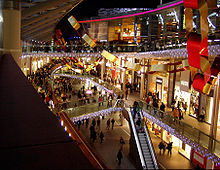 Liverpool ONE has helped move the city into the top five retail destinations in the UK
Liverpool ONE has helped move the city into the top five retail destinations in the UK
Another important component of Liverpool's economy are the tourism and leisure sectors. Liverpool is the 6th most visited city in the United Kingdom[106] and one of the 100 most visited cities in the world by international tourists.[107] In 2008, during the city's European Capital of Culture celebrations, overnight visitors brought £188m into the local economy,[106] while tourism as a whole is worth approximately £1.3bn a year to Liverpool.[105] The city's new cruise liner terminal, which is situated close to the Pier Head, also makes Liverpool one of the few places in the world where cruise ships are able to berth right in the centre of the city.[108] Other recent developments in Liverpool such as the Echo Arena and Liverpool One have made Liverpool an important leisure centre with the latter helping to lift Liverpool into the top five retail destinations in the UK.[109]
Historically, the economy of Liverpool was centred around the city's port and manufacturing base, although today less than 10% of employment in the city are in these sectors.[101] Nonetheless the city remains one of the most important ports in the United Kingdom, handling over 32.2m tonnes of cargo in 2008.[110] It is also home to the UK headquarters of many shipping lines including Japanese firm NYK and Danish firm Maersk Line.[111][112] Future plans to redevelop the city's northern dock system, in a project known as Liverpool Waters, could see £5.5bn invested in the city over the next 50 years, creating 17,000 new jobs.[113]
Car-manufacturing also takes place in the city at the Halewood plant where the Jaguar X-Type and Land Rover Freelander models are assembled.
Landmarks
Main articles: Architecture of Liverpool and Liverpool Maritime Mercantile CityLiverpool's history means that there are a considerable variety of architectural styles found within the city, ranging from 16th century Tudor buildings to modern-day contemporary architecture.[114] The majority of buildings in the city date from the late-18th century onwards, the period during which the city grew into one of the foremost powers in the British Empire.[115] There are over 2,500 listed buildings in Liverpool, of which 27 are Grade I listed[116] and 85 are Grade II* listed.[117] The city also has a greater number of public sculptures than any other location in the United Kingdom aside from Westminster[118] and more Georgian houses than the city of Bath.[119] This richness of architecture has subsequently seen Liverpool described by English Heritage, as England's finest Victorian city.[120] The value of Liverpool's architecture and design was recognised in 2004, when several areas throughout the city were declared a UNESCO World Heritage Site. Known as the Liverpool Maritime Mercantile City, the sites were added in recognition of the city's role in the development of international trade and docking technology.[121]
Waterfront and docks
As a major British port, the docks in Liverpool have historically been central to the city's development. Several major docking firsts have occurred in the city including the construction of the world's first enclosed wet dock (the Old Dock) in 1715 and the first ever hydraulic lifting cranes.[122] The best-known dock in Liverpool is the Albert Dock, which was constructed in 1846 and today comprises the largest single collection of Grade I listed buildings anywhere in Britain.[123] Built under the guidance of Jesse Hartley, it was considered to be one of the most advanced docks anywhere in the world upon completion and is often attributed with helping the city to become one of the most important ports in the world. North of the city centre is Stanley Dock, home to the Stanley Dock Tobacco Warehouse, which was at the time of its construction in 1901, the world's largest building in terms of area[124] and today stands as the world's largest brick-work building.[125]
One of the most famous locations in Liverpool is the Pier Head, renowned for the trio of buildings – the Royal Liver Building, the Cunard Building and the Port of Liverpool Building – which sit upon it. Collectively referred to as the Three Graces, these buildings stand as a testament to the great wealth in the city during the late 19th and early 20th century. Built in a variety of architectural styles, they are recognised as being the symbol of Maritime Liverpool, and are regarded by many as contributing to one of the most impressive waterfronts in the world.[126][127][128][129]
In recent years, several areas along Liverpool's waterfront have undergone significant redevelopment. Amongst the notable recent developments are the construction of the Echo Arena Liverpool and BT Convention Centre on Kings Dock, Alexandra Tower and 1 Princes Dock on Princes Dock and Liverpool Marina around Coburg and Brunswick Docks.
Commercial District and Cultural Quarter
 Liverpool Town Hall, as seen looking up Castle Street. The Building in the foreground on the right is the former Bank of England Building
Liverpool Town Hall, as seen looking up Castle Street. The Building in the foreground on the right is the former Bank of England Building
Liverpool's historic position as one of the most important trading ports in the world has meant that over time many grand buildings have been constructed in the city as headquarters for shipping firms, insurance companies, banks and other large firms. The great wealth this brought, then allowed for the development of grand civic buildings, which were designed to allow the local administrators to 'run the city with pride'.[130]
The commercial district is centred around the Castle Street, Dale Street and Old Hall Street areas of the city, with many of the area's roads still following their medieval layout. Having developed over a period of three centuries the area is regarded as one of the most important architectural locations in the city, as recognised by its inclusion in Liverpool's World Heritage site.[131] The oldest building in the area is the Grade I listed Liverpool Town Hall, which is located at the top of Castle Street and dates from 1754. Often regarded as the city's finest piece of Georgian architecture, the building is noted as one of the most extravagantly decorated civic buildings anywhere in Britain.[132][133] Also on Castle Street is the Grade I listed Bank of England Building, constructed between 1845 and 1848, as one of only three provincial branches of the national bank.[132] Amongst the other noted buildings in the area are the Tower Buildings, Albion House (the former White Star Line headquarters), the Municipal Buildings and Oriel Chambers,[134] which is considered to be one of the earliest Modernist style buildings ever built.[135]
The area around William Brown Street is referred to as the city's 'Cultural Quarter', owing to the presence of numerous civic buildings, including the William Brown Library, Walker Art Gallery, Picton Reading Rooms and World Museum Liverpool. The area is dominated by neo-classical architecture, of which the most prominent, St George's Hall,[136] is widely regarded as the best example of a neo-classical building anywhere in Europe.[137] A Grade I listed building, it was constructed between 1840 and 1855 to serve a variety of civic functions in the city and its doors are inscribed with "S.P.Q.L." (Latin senatus populusque Liverpudliensis), meaning "the senate and people of Liverpool". William Brown Street is also home to numerous public monuments and sculptures, including Wellington's Column and the Steble Fountain. Many others are located around the area, particularly in St John's Gardens, which was specifically developed for this purpose.[138] The William Brown Street area has been likened to a modern recreation of the Roman Forum.[139]
Other notable landmarks
While the majority of Liverpool's architecture dates from the mid-18th century onwards, there are several buildings that pre-date this time. One of the oldest surviving buildings is Speke Hall, a Tudor manor house located in the south of the city, which was completed in 1598.[140] The building is one of the few remaining timber framed Tudor houses left in the north of England and is particularly noted for its Victorian interior, which was added in the mid-19th century.[141] In addition to Speke Hall, many of the city's other oldest surviving buildings are also former manor houses including Croxteth Hall and Woolton Hall, which were completed in 1702 and 1704 respectively.[142] The oldest building within the city centre is the Grade I listed Bluecoat Chambers,[143] which was built between 1717 and 1718. Constructed in British Queen Anne style,[144][145] the building was influenced in part by the work of Christopher Wren[146] and was originally the home of the Bluecoat School (who later moved to larger site in the south of the city). Since 1908 it has acted as a centre for arts in Liverpool.[144]
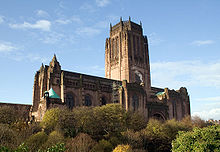 Liverpool Cathedral is regarded as one of the greatest buildings of the twentieth century
Liverpool Cathedral is regarded as one of the greatest buildings of the twentieth century
Liverpool is noted for having two Cathedrals, each of which imposes over the landscape around it.[147] The Anglican Cathedral, which was constructed between 1904 and 1978, is the largest Cathedral in Britain[148] and the fifth largest in the world. Designed and built in Gothic style, it is regarded as one of the greatest buildings to have been constructed during the 20th century[149] and was described by former British Poet Laureate, John Betjeman, as 'one of the great buildings of the world’.[150] The Roman Catholic Metropolitan Cathedral was constructed between 1962 and 1967 and is noted as one of the first Cathedrals to break the traditional longitudinal design.[151]
In recent years, many parts of Liverpool's city centre have undergone significant redevelopment and regeneration after years of decline. The largest of these developments has been Liverpool One, which has seen almost £1 billion invested in the redevelopment of 42 acres (170,000 m2) of land, providing new retail, commercial, residential and leisure space.[152] Around the north of the city centre several new skyscrapers have also been constructed including the RIBA award winning Unity Buildings and West Tower, which at 140m is Liverpool's tallest building. Many future redevelopment schemes are also planned including Central Village (planning permission granted),[153] the Lime Street gateway (work started)[154] and the highly ambitious Liverpool Waters (early planning stage).[155]
There are many other notable buildings in Liverpool, including the art deco former terminal building of Speke Airport, the University of Liverpool's Victoria Building, (which provided the inspiration for the term Red Brick University), and the Adelphi Hotel, which was in that past considered to be one of the finest hotels anywhere in the world.[156]
The English Heritage National Register of Historic Parks describes Merseyside's Victorian Parks as collectively the "most important in the country".[157] The city of Liverpool has ten listed parks and cemeteries, including three Grade II*, more than any other English city apart from London.[158]
Transport
Main article: Transport in LiverpoolThe Wallasey entrance to the Kingsway Tunnel. Liverpool's skyline is visible in the background
Transport in Liverpool is primarily centred around the city's road and rail networks, both of which are extensive and provide links across the United Kingdom. Liverpool has an extensive local public transport network, which is managed by the Merseyside Passenger Transport Executive, and includes buses, trains and ferries. Additionally, the city also has an international airport and a major port, both of which provides links to locations outside the country.
National and international travel
- Road links
As a major city, Liverpool has direct road links with many other areas within England. To the east, the M62 motorway connects Liverpool with Hull and along the route provides links to several large cities, including Manchester, Leeds and Bradford. The M62 also provides a connection to both the M6 motorway and M1 Motorway, providing indirect links to more distant areas including Birmingham, Sheffield, Preston, London and Nottingham.[159] To the west of the city, the Kingsway and Queensway Tunnels connect Liverpool with the Wirral Peninsula, providing links to both Birkenhead, and Wallasey. The A41 road, which begins in Birkenhead, also provides links to Cheshire and Shropshire and via the A55 road, North Wales.[160] To the south, Liverpool is connected to Widnes and Warrington via the A562 road and subsequently across the River Mersey to Runcorn, via the Silver Jubilee Bridge. Plans have been developed in recent years to construct a second bridge, known as the Mersey Gateway, across the river in order to alleviate congestion on the route today.
- Rail links
Liverpool is served by two separate rail networks. The local rail network is managed and run by Merseyrail and provides links throughout Merseyside and beyond (see Local Travel below), while the national network, which is managed by Network Rail, provides Liverpool with connections to major towns and cities across the England. The city's primary mainline station is Lime Street station, which acts as a terminus for several lines into the city. Train services from Lime Street provide connections to numerous destinations, including London (in 2 hours 8 minutes with Pendolino trains), Birmingham, Newcastle upon Tyne, Manchester, Preston, Leeds, Scarborough, Sheffield, Nottingham and Norwich. In the south of the city, Liverpool South Parkway provides a connection to the city's airport.
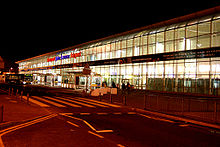 Liverpool John Lennon Airport terminal building
Liverpool John Lennon Airport terminal building
- Port
The Port of Liverpool is one of Britain's largest ports, providing passenger ferry services across the Irish Sea to Belfast, Dublin and the Isle of Man. Services are provided by several companies, including the Isle of Man Steam Packet Company, P&O[disambiguation needed
 ] and Norfolkline. In 2007, a new cruise liner terminal was opened in Liverpool, located alongside the Pier Head in the city centre. The terminal will allow cruise ships to dock in the city (40 ships are due in during 2009[161]) and also provide a base for trans-Atlantic services.[162]
] and Norfolkline. In 2007, a new cruise liner terminal was opened in Liverpool, located alongside the Pier Head in the city centre. The terminal will allow cruise ships to dock in the city (40 ships are due in during 2009[161]) and also provide a base for trans-Atlantic services.[162]- Airport
Liverpool John Lennon Airport, which is located in the south of the city, provides Liverpool with direct air connections across the United Kingdom and Europe. In 2008, the airport handled over 5.3 million passengers[163] and today offers services to 68 destinations,[164] including Berlin, Rome, Milan, Paris, Barcelona and Zürich. The airport is primarily served by low-cost airlines, notably Ryanair and Easyjet, although it does provide additional charter services in the summer. In addition, Dutch airline KLM currently provides a four-times daily service to Amsterdam from JLA, providing passengers with the option to fly to over 800 destinations across the world with the airline, via the Dutch airport.[165]
Local Travel
 The Merseyrail network has extensive underground sections within the city centre
The Merseyrail network has extensive underground sections within the city centre
- Buses
Local bus services within and around Liverpool are managed by the Merseyside Passenger Transport Executive (more commonly known as Merseytravel)[166] and are run by several different companies, including Arriva and Stagecoach. The two principal termini for local buses are Queen Square Bus Station (located near Lime Street railway station) for services north and east of the city, and Liverpool One Bus Station formerly known as Paradise Street Bus Interchange (located near the Albert Dock) for services to the south and east. Cross-river services to the Wirral use roadside terminus points in Castle Street and Sir Thomas Street. A night bus service also operates on Saturdays providing services from the city centre across Liverpool and Merseyside.[167]
MV Royal Iris of the Mersey is one of three ferries that provide cross river services between Liverpool and the Wirral
- Trains
Liverpool's local rail network is one of the busiest and most extensive in the country. The network consists of three lines: the Northern Line, which runs to Southport, Ormskirk, Kirkby and Hunts Cross; the Wirral Line, which runs through the Mersey Railway Tunnel and has branches to New Brighton, West Kirby, Chester and Ellesmere Port; and the City Line, which begins at Lime Street, providing links to St Helens, Wigan, Preston, Warrington and Manchester.
The network is predominantly electric, with diesel trains running on the City Line. The two lines operated by Merseyrail are the busiest British urban commuter networks outside London, covering 75 miles (121 km) of track, with an average of 100,000 passenger journeys per weekday.[168][169] Services are operated by the Merseyrail franchise and managed by the Merseyside Passenger Transport Executive. It should be noted that local services on the City Line are operated by Northern Rail rather than Merseyrail, although the line itself remains part of the Merseyrail network. Within the city centre the majority of the network is underground, with five city centre stations and over 6.5 miles (10.5 km) of tunnels.[168]
- Mersey Ferry
The cross river ferry service in Liverpool, known as the Mersey Ferry, is managed and operated by Merseytravel, with services operating between the Pier Head in Liverpool and both Woodside in Birkenhead and Seacombe in Wallasey. Services operate at intervals ranging from 20 minutes at peak times, to every hour during the middle of the day and during weekends.[170] Despite remaining an important transport link between the city and the Wirral Peninsula, the Mersey Ferry has become an increasingly popular tourist attraction within the city, with daytime River Explorer Cruises providing passengers with an historical overview of the River Mersey and surrounding areas.[171]
Culture
Liverpool was the birthplace of the Beatles Main article: Culture of Liverpool
Main article: Culture of LiverpoolAs with other large cities, Liverpool is an important cultural centre within the United Kingdom, incorporating music, performing arts, museums and art galleries, literature and nightlife amongst others. In 2008, the cultural heritage of the city was celebrated with the city holding the title of European Capital of Culture, during which time a wide range of cultural celebrations took place in the city, including Go Superlambananas! and La Princesse.
Music
Main articles: Music of Liverpool and Beat musicLiverpool is internationally known for music and is recognised by Guinness World Records as the World Capital City of Pop.[172] Musicians from the city have produced 56 number one singles, more than any other city in the world.[173][174] Both the most successful male band and girl group in global music history have contained Liverpudlian members. Liverpool is most famous as the birthplace of The Beatles and during the 1960s was at the forefront of the Beat Music movement, which would eventually lead to British Invasion. Many notable musicians of the time originated in the city including Billy J Kramer, Cilla Black, Gerry & the Pacemakers and The Searchers. The influence of musicians from Liverpool, coupled with other cultural exploits of the time, such as the Liverpool poets, prompted American poet Allen Ginsburg to proclaim that the city was "the centre of consciousness of the human universe".[175] Other musicians from Liverpool have included Billy Fury, A Flock of Seagulls, Echo and the Bunnymen, Frankie Goes to Hollywood, Frankie Vaughan and more recently Ladytron, The Zutons, Atomic Kitten and Heidi Range.
The city is also home to the oldest surviving professional symphony orchestra in the UK, the Royal Liverpool Philharmonic Orchestra, which is based in the Philharmonic Hall.[176] The current chief conductor of the orchestra is Vasily Petrenko.[177] Sir Edward Elgar dedicated his famous Pomp and Circumstance March No. 1 to the Liverpool Orchestral Society, and the piece had its first performance in the city in 1901.[citation needed] Among Liverpool's curiosities, the Austrian émigré Fritz Spiegl is notable. He not only became a world expert on the etymology of Scouse, but composed the music to Z-cars and the Radio 4 UK Theme.
The Mathew Street Festival is an annual street festival that is one of the most important musical events in Liverpool's calendar. The dance music festival Creamfields was established by the famous Liverpool-based Cream clubbing brand which started life as a weekly event at Nation nightclub. and There are numerous music venues located acrsoss the city, however the Echo Arena is by far the largest. Opened in 2008 the 11,000-seater arena hosted the MTV Europe Music Awards the same year and since then has held host to world renowned acts such as Andrea Bocelli, Beyoncé, Elton John, Kanye West, Kasabian, The Killers, Lady Gaga, Oasis, Pink, Rihanna, UB40.
Visual arts
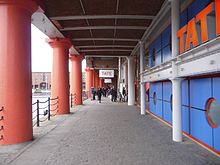 Tate Liverpool art gallery
Tate Liverpool art gallery
Liverpool has more galleries and national museums than any other city in the United Kingdom apart from London.[178] National Museums Liverpool is the only English national collection based wholly outside London.[179] The Tate Liverpool gallery houses the modern art collection of the Tate in the North of England and was, until the opening of Tate Modern, the largest exhibition space dedicated to modern art in the United Kingdom. The FACT centre hosts touring multimedia exhibitions, while the Walker Art Gallery houses an extensive collection of Pre-Raphaelites. Sudley House contains another major collection of pre 20th century art,[180] and the number of galleries continues to expand: Ceri Hand Gallery opened in 2008, exhibiting primarily contemporary art, and Liverpool University's Victoria Building was re-opened as a public art gallery and museum to display the University's artwork and historical collections which include the second-largest display of art by Audubon outside the US.[181] A number of artists have also come from the city, including painter George Stubbs who was born in Liverpool in 1724.
The Liverpool Biennial festival of arts runs from mid-September to late November and comprises three main sections; the International, The Independents and New Contemporaries although fringe events are timed to coincide.[182] It was during the 2004 festival that Yoko Ono's work "My mother is beautiful" caused widespread public protest when photographs of a naked woman's pubic area were exhibited on the main shopping street. Despite protests the work remained in place[citation needed].
Literature
A number of notable authors have visited Liverpool including Daniel Defoe, Washington Irving, Thomas De Quincey, Herman Melville, Nathaniel Hawthorne, Charles Dickens, Gerald Manley Hopkins and Hugh Walpole all of whom spent extended periods in the city[citation needed]. Hawthorne was stationed in Liverpool as United States consul between 1853 and 1856[citation needed]. Although he is not known to have ever visited Liverpool, Jung famously had a vivid dream of the city which he analysed in one of his works.[183]
During the late 1960s the city became well known for the Liverpool poets, who include Roger McGough and the late Adrian Henri. An anthology of poems, The Mersey Sound, written by Henri, McGough and Brian Patten, has sold over 500,000 copies since first being published in 1967[citation needed].
June Bhatia, who writes under the name Helen Forrester, has published many novels about Liverpool, as well as her autobiography Twopence to Cross the Mersey, and its three sequels.
Liverpool has produced several noted writers of horror fiction, often set on Merseyside - Clive Barker and Peter Atkins among them. A collection of Liverpudlian horror fiction, Spook City was edited by a Liverpool expatriate, Angus Mackenzie, and introduced by Doug Bradley, also from Liverpool.[184] Bradley is famed for portraying Barker's creation Pinhead in the Hellraiser series of films. Waterstones Bookshop in Liverpool One hosts an irregular but frequent celebration of horror fiction, Twisted Tales.
Performing Arts
Liverpool also has a history of performing arts, reflected in several annual theatre festivals such as the Liverpool Shakespeare Festival which takes place inside Liverpool Cathedral and in the adjacent historic St James' Gardens every summer, The Everyword Festival of new theatre writing, the only one of its kind in the country,[185] Physical Fest, an international festival of physical theatre, organised by Tmesis,[186] the annual festivals run by John Moores University Drama department and LIPA, and by the number of theatres in the city. These include the Empire, Everyman, Liverpool Playhouse, Neptune, Royal Court and Unity theatres. The Everyman and Playhouse are now both part of one company, and both houses produce their own work as well as receiving touring productions.[187][188] The Everyman is due to be rebuilt, with the current building demolished in 2011 and a new venue on the same site planned for a 2013 opening.[189]
Education
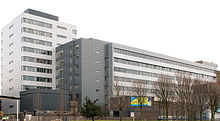 Liverpool John Moores University's James Parsons Building
Liverpool John Moores University's James Parsons Building
In Liverpool primary and secondary education is available in various forms supported by the state including secular, Church of England, Jewish, and Roman Catholic. Islamic education is available at primary level, but there is currently no secondary provision. One of Liverpool's important early schools was The Liverpool Blue Coat School; founded in 1708 as a charitable school.
The Liverpool Blue Coat School is the top-performing school in the city with 100% 5 or more A*-C grades at GCSE resulting in the 30th best GCSE results in the country and an average point score per student of 1087.4 in A/AS levels.[190] Other notable schools include Liverpool College founded in 1840 Merchant Taylors' School founded in 1620.[191] Another of Liverpool's notable senior schools is St. Edward's College situated in the West Derby area of the city. Historic grammar schools, such as the Liverpool Institute High School and Liverpool Collegiate, closed in the 1980s are still remembered as centres of academic excellence. Bellerive Catholic College is the city's top performing non selective school, based upon GCSE results in 2007.
Liverpool has three universities: the University of Liverpool, Liverpool John Moores University and Liverpool Hope University. Edge Hill University, originally founded as a teacher-training college in the Edge Hill district of Liverpool, is now located in Ormskirk in South-West Lancashire. Liverpool is also home to the Liverpool Institute for Performing Arts (LIPA).
The University of Liverpool, was established in 1881 as University College Liverpool. In 1884, became part of the federal Victoria University. Following a Royal Charter and Act of Parliament in 1903, it became an independent university, the University of Liverpool, with the right to confer its own degrees. It was the first university to offer degrees in biochemistry, architecture, civic design, veterinary science, oceanography and social science.
Liverpool Hope University, which was formed through the merger of three colleges, the earliest of which was founded in 1844, gained university status in 2005. It is the only ecumenical university in Europe.[192] It is situated on both sides of Taggart Avenue in Childwall and has a second campus in the city centre (the Cornerstone).
The Liverpool School of Tropical Medicine, founded to address some of the problems created by trade, continues today as a post-graduate school affiliated with the University of Liverpool and is one of only two institutions internationally that house the de facto standard anti-venom repository.[citation needed]
Liverpool John Moores University was previously a polytechnic, and gained status in 1992. It is named in honour of Sir John Moores, one of the founders of the Littlewoods football pools and retail group, who was a major benefactor. The institution was previously owned and run by Liverpool City Council.
The city has one further education college, Liverpool Community College. Liverpool City Council operates Burton Manor, a residential adult education college in nearby Burton, on the Wirral Peninsula.
There are two Jewish schools in Liverpool, both belonging to the King David Foundation. King David School, Liverpool is the High School and the King David Primary School. There is also a King David Kindergarten, featured in the community centre of Harold House. These schools are all run by the King David Foundation based in Harold House in Childwall; conveniently next door to the Childwall Synagogue
Sport
Liverpool is home to the Premier League football clubs Everton and Liverpool F.C. The city of Liverpool is the only one in England to have staged top division football every single season since the formation of the Football League in 1888, and both of the city's clubs play in high-capacity stadiums. Both Everton and Liverpool have played in the Premier League for every season since its inception in 1992.
Everton are the older of Liverpool's two professional football clubs. They were founded in 1878 and have played at Goodison Park since 1892, when they relocated from the Anfield stadium that was taken over by the new Liverpool club. Everton have been league champions nine times, FA Cup winners five times and European Cup Winners' Cup winners once.[193] Their most successful managers were Harry Catterick and Howard Kendall. Many high profile players have worn the Everton shirt. These include Dixie Dean (who scored a record 60 goals in a single league season), Tommy Lawton, Brian Labone, Ray Wilson, Alan Ball (who both featured in England's World Cup winning side of 1966), Neville Southall, Andy Gray, Gary Lineker, Andrei Kanchelskis, Dave Watson and Wayne Rooney.
Liverpool F.C. are one of the most successful teams in English football, having won 18 league titles, seven FA Cups, seven League Cups, five European Cups and three UEFA Cups. They formed in 1892 and have spent their entire history at the Anfield stadium which they occupied on their formation; it had previously been home to Everton. Liverpool have been in the top flight of English football continuously since 1962 and have been managed by Bill Shankly, Bob Paisley, Joe Fagan, Kenny Dalglish (who also played for the club and for a while was player-manager), Gerard Houllier, Rafael Benítez and Roy Hodgson. Famous Liverpool players include Billy Liddell, Ian St. John, Roger Hunt, Ron Yeats, Emlyn Hughes, Kevin Keegan, Ian Rush, Graeme Souness, Robbie Fowler and Steven Gerrard. However, the club also has an association with tragedy; in 1985, rioting on the terraces during the European Cup final at Heysel Stadium in Brussels, Belgium, resulted in the death of 39 spectators (almost all of them Juventus supporters) and led to all English clubs being barred from European competitions for the next five years (with Liverpool having to serve an extra year when all other English clubs were re-admitted). Four years later, 94 Liverpool fans (the toll eventually reached 96) were crushed to death at Hillsborough Stadium in Sheffield at the FA Cup semi-final. This tragedy led to the Taylor Report which saw standing accommodation banned from all top division stadiums by the mid-1990s.
Since the turn of the 21st century, both Liverpool-based clubs have been considering relocation to new stadiums. Liverpool have been planning a new stadium on nearby Stanley Park for some years, while Everton are currently investigating the possibility of a new stadium in Kirkby after an earlier project to relocate to King's Dock fell through due to financial difficulties.
Professional basketball came to the city in 2007 with the entry of Everton Tigers, now known as Mersey Tigers, into the elite British Basketball League. The club was originally associated with Everton F.C., and was part of the Toxteth Tigers youth development programme, which reached over 1,500 young people every year.[194] The Tigers began play in Britain's top league for the 2007–08 season, playing at the Greenbank Sports Academy before moving into the newly completed Echo Arena during that season. After the 2009–10 season, Everton F.C. withdrew funding from the Tigers, who then changed their name to Mersey Tigers. Their closest professional rivals are the Chester Jets, based 18 miles (29 km) away in Chester.
County cricket is occasionally played in Liverpool, with Lancashire County Cricket Club typically playing one match every year at Liverpool Cricket Club, Aigburth.
Aintree Racecourse to the north of Liverpool in the adjacent borough of Sefton is home to the famous steeplechase, the Grand National, One of the most famous events in the international horse racing calendar, it is held in early April each year. In addition to horse-racing, Aintree has also hosted motor racing, including the British Grand Prix in the 1950s and 1960s.
Liverpool Harriers, who meet at Wavertree Athletics Centre, are one of five athletic clubs. Liverpool has a long history of boxing that has produced John Conteh, Alan Rudkin and Paul Hodkinson and hosts high level amateur boxing events. Park Road Gymnastics Centre provides training to a high level. The City of Liverpool Swimming Club has been National Speedo League Champions 8 out of the last 11 years. Liverpool Tennis Development Programme based at Wavertree Tennis Centre is one of the largest in the UK.[195] Liverpool is also home to the Red Triangle Karate Club, which provided many of the 1990 squad that won the World Shotokan Championships in Sunderland. Luminaries include Sensei Keinosuke Enoeda, Sensei Frank Brennan, Sensei Omry Weiss, Sensei Dekel Kerer, Sensei Andy Sherry and Sensei Terry O'Neill, who is also famous for various acting roles.
Rugby league is played at amateur and student level within the city; the last professional team bearing the city's name was Liverpool City, which folded in the 1960s. Rugby union has a long, if low key, history in the city with Liverpool Football Club, formed in 1857, making them the oldest open rugby team in the world. They merged with St Helens RUFC in 1986 to form Liverpool St Helens.[196] In Sefton there is Waterloo Rugby Club located in Blundellsands. Established in 1882, they now play in National League 2 North.
Liverpool is one of three cities which still host the traditional sport of British baseball and it hosts the annual England-Wales international match every two years, alternating with Cardiff and Newport. Liverpool Trojans are the oldest existing baseball club in the UK.
The Royal Liverpool Golf Club, situated in the nearby town of Hoylake on the Wirral Peninsula, has hosted The Open Championship on a number of occasions, most recently in 2008. It also hosted the Walker Cup in 1983.
Sports stadia
Liverpool have played at Anfield since 1892, when the club was formed to occupy the stadium following Everton's departure due to a dispute with their landlord. Liverpool are still playing there 116 years later, although the ground has been completely rebuilt since the 1970s and only the Main Stand survives from before 1992. The Spion Kop (rebuilt as an all-seater stand in 1994/1995) was the most famous part of the ground, gaining cult status across the world due to the songs and celebrations of the many fans who packed onto its terraces. Anfield is classified as a 4 Star UEFA Elite Stadium with capacity for 45,000 spectators in comfort, and is a distinctive landmark in an area filled with smaller and older buildings. Liverpool club also has a multi-million dollar youth training facility called The Academy.
Goodison Park, the home of Everton F.C
After leaving Anfield in 1892, Everton moved to Goodison Park on the opposite side of Stanley Park. Goodison Park was the first major football stadium built in England. Molineux (Wolves' ground) had been opened three years earlier but was still relatively undeveloped. St. James's Park, Newcastle, opened in 1892, was little more than a field. Only Scotland had more advanced grounds. Rangers opened Ibrox in 1887, while Celtic Park was officially inaugurated at the same time as Goodison Park. Everton performed a miraculous transformation at Mere Green, spending up to £3000 on laying out the ground and erecting stands on three sides. For £552 Mr. Barton prepared the land at 4½d a square yard. Kelly Brothers of Walton built two uncovered stands each for 4,000 people, and a covered stand seating 3,000, at a total cost of £1,460. Outside, hoardings cost a further £150, gates and sheds cost £132 10s and 12 turnstiles added another £7 15s to the bill.
The ground was immediately renamed Goodison Park and proudly opened on 24 August 1892, by Lord Kinnaird and Frederick Wall of the FA. But instead of a match the 12,000 crowd saw a short athletics meeting followed by a selection of music and a fireworks display. Everton's first game there was on 2 September 1892 when they beat Bolton 4–2. It now has the capacity for more than 40,000 spectators all-seated, but the last expansion took place in 1994 when a new goal-end stand gave the stadium an all-seater capacity. The Main Stand dates back to the 1970s, while the other two stands are refurbished pre-Second World War structures.
There are currently plans for both stadiums to be pulled down and for the teams to relocate. Liverpool have been considering a move to a new stadium in Stanley Park since 2000; seven years on work has started and the 60,000-seat stadium is expected to be ready by 2014.
Everton have been considering relocation since 1996, and in 2003 were forced to scrap plans for a 55,000-seat stadium at King's Dock due to financial reasons. The latest plan has been to move beyond Liverpool's council boundary to Kirkby, but this has proved controversial with some fans, as well as members of the local community. At one point there was much talk for Everton to ground-share with Liverpool, at the proposed new stadium in Stanley Park, but this was not progressed by either club.
Media
The ITV region which covers Liverpool is ITV Granada. In 2006, the Television company opened a new newsroom in the Royal Liver Building. Granada's regional news broadcasts were produced at the Albert Dock News Centre during the 1980s and 1990s.[197] The BBC also opened a new newsroom on Hanover Street in 2006.
ITV's daily magazine programme This Morning was famously broadcast from studios at Albert Dock until 1996, when production was moved to London. Granada's short-lived shopping channel "Shop!" was also produced in Liverpool until it was axed in 2002.
Liverpool is the home of the TV production company Lime Pictures, formerly Mersey Television, which produced the now-defunct soap operas Brookside and Grange Hill. It also produces the current soap opera Hollyoaks, which was formerly filmed in Chester and began on Channel 4 in 1995. All three series were/are largely filmed in the Childwall area of Liverpool.
The city has two daily newspapers: the morning Daily Post and the evening Echo, both published by the same company, the Trinity Mirror group. The Daily Post, especially, serves a wider area, including north Wales. The UK's first online only weekly newspaper called Southport Reporter (Southport & Mersey Reporter), is also one of the many other news outlets that covers the city. Radio stations include BBC Radio Merseyside, Juice FM, and Radio City 96.7, City Talk 105.9, as well as Magic 1548. The last three are based in Radio City Tower which, along with the two cathedrals, dominates the city's skyline. The independent media organisation Indymedia also covers Liverpool, while 'Nerve' magazine publishes articles and reviews of cultural events.
Liverpool has also featured in films;[198] see List of films set in Liverpool for some of them. In films the city has "doubled" for London, Paris, New York, Moscow, Dublin, Venice and Berlin.[12][199]
Liverpool was the host city for the 2008 MTV Europe Music Awards.
Notable people
Main articles: List of people from Merseyside and List of bands from MerseysideQuotes about Liverpool
- "Lyrpole, alias Lyverpoole, a pavid towne, hath but a chapel... The king hath a castelet there, and the Earl of Darbe hath a stone howse there. Irisch merchants cum much thither, as to a good haven... At Lyrpole is smaul custom payed, that causith marchantes to resorte thither. Good marchandis at Lyrpole, and much Irish yarrn that Manchester men do buy there..." – John Leland (antiquary), Itinery, c. 1536–39
- "Liverpoole is one of the wonders of Britain... In a word, there is no town in England, London excepted, that can equal [it] for the fineness of the streets, and the beauty of the buildings." Daniel Defoe – A tour thro' the Whole Island of Great Britain, 1721–26
- "[O]ne of the neatest, best towns I have seen in England." – John Wesley. Journal, 1755
- "I have not come here to be insulted by a set of wretches, every brick in whose infernal town is cemented with an African's blood." Actor George Frederick Cooke (1756–1812) responding to being hissed when he came on stage drunk during a visit to Liverpool.[200]
- "That immense City which stands like another Venice upon the water...where there are riches overflowing and every thing which can delight a man who wishes to see the prosperity of a great community and a great empire... This quondam village, now fit to be the proud capital of any empire in the world, has started up like an enchanted palace even in the memory of living men." Thomas Erskine, 1st Baron Erskine, 1791
- "I have heard of the greatness of Liverpool but the reality far surpasses my expectation" – Prince Albert, speech, 1846
- "Liverpool…has become a wonder of the world. It is the New York of Europe, a world city rather than merely British provincial." – Illustrated London News, 15 May 1886
- "Liverpool is the 'pool of life' " – C.G. Jung, Memories, Dreams, Reflections, 1928
- "The centre is imposing, dignified and darkish, like a city in a rather gloomy Victorian novel...We had now arrived in the heart of the big city, and as usual it was almost a heart of darkness. But it looked like a big city, there was no denying that. Here, emphatically, was the English seaport second only to London. The very weight of stone emphasised that fact. And even if the sun never seems to properly rise over it, I like a big city to proclaim itself a big city at once..." – J.B. Priestley, English Journey, 1934
- "...if Liverpool can get into top gear again there is no limit to the city's potential. The scale and resilience of the buildings and people is amazing – it is a world city, far more so than London and Manchester. It doesn't feel like anywhere else in Lancashire: comparisons always end up overseas – Dublin, or Boston, or Hamburg. The city is tremendous, and so, right up to the First World War, were the abilities of the architects who built over it…… The centre is humane and convenient to walk around in, but never loses its scale. And, in spite of the bombings and the carelessness, it is still full of superb buildings. Fifty years ago it must have outdone anything in England." – Ian Nairn, Britain's Changing Towns, 1967
International links
Twin cities
Liverpool is twinned[201][202] with the following cities:
Country Place County / District / Region / State Date 
Germany 
Cologne 
North Rhine-Westphalia 1952 
Republic of Ireland 
Dublin 
Leinster 1997 
China Shanghai Shanghai Municipality 1999 
Brazil 
Rio de Janeiro 
Rio de Janeiro 2003 Friendship links
Liverpool has friendship links (without formal constitution)[203] with the following cities:
 Givenchy-lès-la-Bassée, France
Givenchy-lès-la-Bassée, France Halifax, Canada
Halifax, Canada Havana, Cuba
Havana, Cuba La Plata, Argentina
La Plata, Argentina Memphis, US
Memphis, US Minamitane, Japan
Minamitane, Japan Naples, Italy
Naples, Italy New Orleans, US
New Orleans, US Odessa, Ukraine
Odessa, Ukraine Ponsacco, Italy
Ponsacco, Italy Râmnicu Vâlcea, Romania
Râmnicu Vâlcea, Romania Valparaíso, Chile
Valparaíso, Chile
Other links
Liverpool also has links with the following cities:
 New York, US – Freedom of the City of Liverpool – August 2003
New York, US – Freedom of the City of Liverpool – August 2003 Riga, Latvia – Letter of Intent signed – March 2003
Riga, Latvia – Letter of Intent signed – March 2003 Stavanger, Norway – Letter of Intent signed – June 2004
Stavanger, Norway – Letter of Intent signed – June 2004
Consulates in Liverpool
 Cape Verdean Consulate
Cape Verdean Consulate Hungarian Consulate
Hungarian Consulate Italian Consulate
Italian Consulate Netherlands Consulate
Netherlands Consulate Norwegian Consulate
Norwegian Consulate Royal Swedish Consulate
Royal Swedish Consulate Royal Thai Consulate
Royal Thai Consulate United States Consulate (former)
United States Consulate (former)
See also
- 1911 Liverpool general transport strike
- 2008 European Amateur Boxing Championships
- La Princesse, the giant mechanical spider roaming the streets in September 2008
- Big Dig (Liverpool)
- Culture in Liverpool
- List of films and television shows set in Liverpool
- International Garden Festival
- Port of Liverpool
- Williamson Tunnels
- Liverpool Football Club
- Everton Football Club
- Magistrates Courts, Liverpool
Further reading
- Liverpool, Dixon Scott, 1907
- A History of Liverpool, Ramsay Muir, 1907
- Bygone Liverpool, Ramsay Muir, 1913
- Bygone Liverpool, David Clensy, 2008. ISBN 978-1-4357-0897-6
- Liverpool 800, John Belchem, 2006. ISBN 978-1-84631-035-5
- Chinese Liverpudlians, Maria Lin Wong, 1989. ISBN 978-1-871201-03-1
- Writing Liverpool: Essays and Interviews, edited by Michael Murphy and Rees Jones, 2007. ISBN 978-1-84631-073-7
References
Notes
- ^ "Is Liverpool still the world in one city?". http://www.liv.ac.uk/news/press_releases/2006/07/liverpool800.htm. Retrieved 2010-05-01.
- ^ a b "Neighbourhood Statistics: Resident Population Estimates by Ethnic Group (Percentages)". Office for National Statistics. http://www.neighbourhood.statistics.gov.uk/dissemination/LeadTableView.do?a=7&b=276787&c=liverpool&d=13&e=13&g=359393&i=1001x1003x1004&m=0&r=1&s=1305914899812&enc=1&dsFamilyId=1812. Retrieved 2011-05-20.
- ^ "Key Statistics for urban areas in the North – Contents, Introduction, Tables KS01 – KS08". Office for National Statistics. http://www.statistics.gov.uk/downloads/census2001/ks_urban_north_part_1.pdf. Retrieved 2010-01-28.
- ^ Many people "self-identify" as Liverpudlians or Scousers without actually being born or living within the city boundaries of Liverpool. Many people from within the greater Merseyside area consider themselves thus, although many don't. Conversely, a number of people from Liverpool itself may not consider themselves Scousers, since the term for them may have pejorative overtones.
- ^ "Report on the Nominations from the UK and Norway for the European Capital of Culture 2008" (PDF). http://ec.europa.eu/culture/pdf/doc1155_en.pdf. Retrieved 2008-07-11.
- ^ "Liverpool – Maritime Mercantile City". UK Local Authority World Heritage Forum. Archived from the original on 2008-04-23. http://web.archive.org/web/20080423041054/http://www.lawhf.gov.uk/LAWHF/liverpool.htm. Retrieved 2008-10-09.
- ^ "The Lost Dock of Liverpool". Channel 4: Time Team, 21 April 2008. http://www.channel4.com/history/microsites/T/timeteam/2008/liverpool/liverpool-found.html. Retrieved 2008-06-02.
- ^ "Liverpool Dock System". New York Times, 2 January 1898. 1898-01-02. http://query.nytimes.com/gst/abstract.html?res=9C07EFD91039E433A25751C0A9679C94699ED7CF. Retrieved 2008-06-02. Note: "pdf" reader needed to see full article
- ^ Liverpool Beach. SCAR Composite Gazetteer of Antarctica.
- ^ "Riots and lynchings, fascists and immigrants: what's changed?". Searchlight Magazine. http://www.searchlightmagazine.com/index.php?link=template&story=35. Retrieved 2011-08-05.
- ^ [1]
- ^ a b Ten facts about Liverpool Telegraph, 4 June 2003
- ^ Hatton, Brian (2008). Shifted tideways: Liverpool's changing fortunes. The Architectural Review. http://findarticles.com/p/articles/mi_m3575/is_1331_223/ai_n24265855/?tag=content;col1.
- ^ Henderson, W.O. (1933). The Liverpool office in London. Economica xiii. London School of Economics. pp. 473–479.
- ^ The Bankers' Magazine. v.11. London: Groombridge & Sons. 1851. http://books.google.co.uk/books?id=nC05AAAAMAAJ&pg=PA783&dq=new-york-of-europe&client=firefox-a.
- ^ "Spirit of the Blitz : Liverpool in the Second World War". Liverpool Museums. 2003. http://www.liverpoolmuseums.org.uk/maritime/exhibitions/blitz/blitz.asp. Retrieved 2010-09-13.
- ^ "Merseyside Maritime Museum, Sheet No. 4: Battle of the Atlantic". Liverpoolmuseums.org.uk. 1939-09-03. http://www.liverpoolmuseums.org.uk/maritime/archive/displayGuide.aspx?sid=4&mode=html&sorStr=&serStr=&pgeInt=&catStr=. Retrieved 2010-08-03.
- ^ "Victoria & Albert Museum. London". Vam.ac.uk. 2005-06-01. http://www.vam.ac.uk/collections/periods_styles/19thcentury/steam/other_transport/index.html. Retrieved 2010-08-03.
- ^ "Suburban Electric Railway Association, Coventry". Emus.co.uk. http://www.emus.co.uk/zone/mersey/mersey.htm. Retrieved 2010-08-03.
- ^ Bagwell, Philip Sidney (2006). Transport in Britain 1750–2000. Continuum International Publishing Group. ISBN 9781852855901. http://books.google.co.uk/books?id=OcY5PkqeqgIC&pg=PA170&dq=helicopter+1950+liverpool+cardiff&num=100&client=firefox-a.
- ^ Liverpool Wiki Liverpool's Historic Rail Tunnels
- ^ "Royal School for the Blind, Liverpool". Rsblind.org.uk. 1999-03-12. http://www.rsblind.org.uk/map.html. Retrieved 2010-08-03.
- ^ Bisson, Frederick (1884). Our schools and colleges. London: Simpkin, Marshall. http://books.google.co.uk/books?id=XcNJZAcjHQwC&q=girls+school+1844+liverpool+first&dq=girls+school+1844+liverpool+first&num=100&client=firefox-a.
- ^ "Charles Dickens, speech, 26 Feb, 1844". Dickens.classicauthors.net. http://dickens.classicauthors.net/speeches/speeches7.html. Retrieved 2010-08-03.
- ^ "The Scottie Press". The Scottie Press. http://www.scottiepress.org.uk/projects/martinplq.htm. Retrieved 2010-08-03.
- ^ Adler, N (1925). The work of Juvenile Courts. Third Series, Vol.7, No.4. Cambridge University Press: Journal of International and Comparative Law. pp. 217–227. http://www.jstor.org/pss/753176.
- ^ Garner, Robert (1993). Animals, politics, and morality. Manchester: University Press. ISBN 9780719035753. http://books.google.co.uk/books?id=GSK8AAAAIAAJ&pg=PA41&dq=liverpool+rspca+wanton-cruelty&num=100&client=firefox-a.
- ^ Hendrick, Harry (2005). Child welfare and social policy – an essential reader. The Policy Press. ISBN 9781861345660. http://books.google.co.uk/books?id=eYr7CllxrLUC&pg=PA37&dq=nspcc+liverpool+first&num=100&client=firefox-a.
- ^ Derren Hayes. "communitycare.co.uk". communitycare.co.uk. http://www.communitycare.co.uk/Articles/2009/01/01/110282/liverpool-pss-planting-the-seed-of-modern-social-work.html. Retrieved 2010-08-03.
- ^ Jackie Rand (2009-05-01). "BBC Politics Show, 1 May 2009". BBC News. http://news.bbc.co.uk/1/hi/programmes/politics_show/8022549.stm. Retrieved 2010-08-03.
- ^ Wohl, Anthony S. (1984). Endangered Lives: Public Health in Victorian Britain. Taylor & Francis. ISBN 9780416379501. http://books.google.co.uk/books?id=E5kOAAAAQAAJ&pg=PA73&dq=public+baths+liverpool+rathbone&client=firefox-a.
- ^ British Medical Journal 14 February 1948
- ^ Dennis, Richard (1986). English Industrial Cities of the Nineteenth Century: A Social Geography.. Cambridge University Press. ISBN 9780521338394. http://books.google.co.uk/books?id=NQQQ5Dq9RWgC&pg=PA167&dq=liverpool+first+slum+clearance&num=100&client=firefox-a.
- ^ "Liverpool Medical Institution". Lmi.org.uk. http://www.lmi.org.uk/ambulance_merseyside.html. Retrieved 2010-08-03.[dead link]
- ^ Peltier, Leonard F. (1990). Fractures: a history and iconography of their treatment. Norman Publishing. ISBN 9780930405168. http://books.google.co.uk/books?id=kdBfBd5BdEwC&pg=PA227&dq=first+x-ray+1896+lodge+liverpool&client=firefox-a.
- ^ Wallington, Neil. One Hundred Years of the British Fire Engine. Jeremy Mills Publishing. ISBN 9781906600303. http://books.google.co.uk/books?id=7LZain9YBTkC&pg=PA9&dq=fire-engine+motorised+liverpool+1901&client=firefox-a.
- ^ "National Museums,Liverpool". Liverpoolmuseums.org.uk. http://www.liverpoolmuseums.org.uk/mol/collections/liverpoollives/jessie_reid_crosbie.aspx. Retrieved 2010-08-03.
- ^ BBC News 12 May 1998
- ^ Liverpool University press release, 22 February 2006
- ^ "Liverpool School of Tropical Medicine". Liv.ac.uk. http://www.liv.ac.uk/lstm/about/history_of_the_school.htm. Retrieved 2010-08-03.
- ^ Liverpool's Contributions to Medicine Lord Cohen of Birkenhead BMJ 1965 April 10; 1(5440): 945–948
- ^ 125 years of the International Union of Marine Insurance. Verlag Versicherungswirtsch. 1999. http://books.google.co.uk/books?hl=en&lr=&id=RdVOPhSMsvMC&oi=fnd&pg=PR7&dq=world+liverpool-underwriters+association+oldest+OR+first+1802+OR+1803&ots=K6JCgAIGWT&sig=ckreyVUJwj-LoFZgPapzKOvmTz0. Retrieved 2009-07-14.
- ^ Alexander, Carol; Sheedy, Elizabeth (2007). The Professional Risk Managers' Guide to Financial Markets. McGraw Hill Professional. ISBN 9780071546485. http://books.google.co.uk/books?id=upN4A6jOpkoC&pg=PA126&dq=futures+cotton+derivative+liverpool+rice&num=100&client=firefox-a. Retrieved 2009-07-14.
- ^ "BBC news, 13 May 2008". BBC News. 2008-05-13. http://news.bbc.co.uk/1/hi/england/merseyside/7397702.stm. Retrieved 2010-08-03.
- ^ "Culture 24". Culture 24. 2006-11-26. http://www.culture24.org.uk/mw189. Retrieved 2010-08-03.
- ^ Henley, Darren; McKernan, Vincent (2009), The Original Liverpool Sound: The Royal Liverpool Philharmonic Society, Liverpool: Liverpool University Press, p. 68, ISBN 978-1-84631-224-3
- ^ George R. Matthews (2005). America's first Olympics: the St. Louis games of 1904 University of Missouri Press ISBN 9780826215888
- ^ Ingomar Weiler (2004). The predecessors of the Olympic movement, and Pierre de Coubertin European Review, Vol. 12, No. 3, Cambridge University Press
- ^ Craig Reedie, Jim Parry, Vassil Girginov (2005). The Olympic Games Explained: A Student Guide to the Evolution of the Modern Olympic Games Routledge ISBN 9780415346047
- ^ "Oxford DNB article: Jones, Sir Alfred Lewis". www.oxforddnb.com. http://www.oxforddnb.com/view/article/34222. Retrieved 2010-09-28. (requires login or UK library card)
- ^ Liverpool Scenes 1896/1897 YouTube
- ^ Liverpool City Council News, 14 October 2008
- ^ BBC News 26 May 1999
- ^ "How the council is governed". Liverpool City Council. http://www.liverpool.gov.uk/Council_government_and_democracy/How_the_council_is_governed/index.asp. Retrieved 2008-09-19.
- ^ "The executive management team". Liverpool City Council. Archived from the original on 2008-06-22. http://web.archive.org/web/20080622183306/http://www.liverpool.gov.uk/Council_government_and_democracy/How_the_council_is_managed/Executive_management_team/index.asp. Retrieved 2008-09-19.
- ^ "The leader of the council". Liverpool City Council. Archived from the original on 2008-06-09. http://web.archive.org/web/20080609185521/http://www.liverpool.gov.uk/Council_government_and_democracy/How_the_council_is_governed/Executive_board/Council_leader/index.asp. Retrieved 2008-09-19.
- ^ "The Lord Mayor". Liverpool City Council. Archived from the original on 2008-05-07. http://web.archive.org/web/20080507041633/http://www.liverpool.gov.uk/Council_government_and_democracy/How_the_council_is_governed/Full_council/Lord_Mayor/index.asp. Retrieved 2008-09-19.
- ^ "The Lord Mayor". Civichalls.liverpool.gov.uk. http://www.civichalls.liverpool.gov.uk/lordmayor/index.asp. Retrieved 2010-04-15.
- ^ "Ward Profiles". Liverpool City Council. http://www.liverpool.gov.uk/Business/Economic_development/Key_Statistics_and_Data/Ward_profiles/index.asp. Retrieved 2008-07-03.
- ^ a b "Liverpool Liberal Democrats being wiped out in Local Government elections 2011". Liverpool Echo. http://www.liverpoolecho.co.uk/liverpool-news/local-news/2011/05/06/liverpool-liberal-democrats-being-wiped-out-in-local-government-elections-2011-100252-28644711/. Retrieved 6 May 2011.
- ^ "England Council Elections: Liverpool". BBC News. http://www.bbc.co.uk/news/special/election2011/council/html/by.stm. Retrieved 6 May 2011.
- ^ Coligan, Nick (2008-02-07). "Official: Liverpool city council is worst – yes, the WORST – in the country". Liverpool Echo. http://www.liverpoolecho.co.uk/liverpool-news/local-news/2008/02/07/official-liverpool-city-council-is-worst-yes-the-worst-in-the-country-100252-20446758/. Retrieved 2008-09-23.
- ^ "News - Liverpool Local News - The real legacy of Margaret Thatcher is a nation divided". Liverpool Echo. http://www.liverpoolecho.co.uk/liverpool-news/local-news/2008/07/21/the-real-legacy-of-margaret-thatcher-is-a-nation-divided-100252-21375195/. Retrieved 2011-08-05.
- ^ Wilenius, Paul (2004-03-05). "Enemies within: Thatcher and the unions". BBC News. http://news.bbc.co.uk/1/hi/3067563.stm.
- ^ "Liverpool Members of Parliament". Liverpool City Council. http://www.liverpool.gov.uk/Council_government_and_democracy/MPs_and_MEPs/Liverpool_MPs/index.asp. Retrieved 2008-07-03.
- ^ "Election 2010 – Garston & Halewood". BBC News. http://news.bbc.co.uk/nol/shared/election2010/results/constituency/b80.stm. Retrieved 9 May 2010.
- ^ The Buildings of England – Lancashire: Liverpool and the Southwest By Richard Pollard, Nikolaus Pevsner, Yale University Press, 2006, p243
- ^ "Dec 2010 Minimum". http://www.tutiempo.net/en/Climate/CROSBY/21-12-2010/33160.htm. Retrieved 2011-03-22.
- ^ "Jul 2006 Maximum". http://www.tutiempo.net/en/Climate/CROSBY/19-07-2006/33160.htm. Retrieved 2011-03-22.
- ^ "Climate Normals and extremes". National Oceanography centre. http://www.pol.ac.uk/appl/hist_met/. Retrieved 22 mar 2011.
- ^ "Historical weather for Liverpool, England, United Kingdom". My Forecast. http://www.myforecast.com/bin/climate.m?city=60872&metric=true. Retrieved 2010-12-02.
- ^ "Historical rainfall for Liverpool, England, United Kingdom". Wordtravels. http://www.wordtravels.com/Cities/England/Liverpool/Climate. Retrieved 2010-12-02.
- ^ "Historical sunshine hours for Liverpool, England, United Kingdom". HolidayCheck. http://www.holidaycheck.com/climate-wetter_Liverpool-ebene_oid-id_9053.html. Retrieved 2010-12-02.
- ^ Liverpool Green Infrastructure Strategy - www.ginw.co.uk/liverpool
- ^ "Resident Population Estimates Jun2001, All Persons". Office for National Statistics. 2007-12-18. http://neighbourhood.statistics.gov.uk/dissemination/LeadTableView.do?adminCompAndTimeId=22187%3A131&a=3&b=276787&c=liverpool&d=13&r=1&e=13&f=22194&o=74&g=359393&i=1001x1003x1004x1005&l=1813&m=0&s=1221897754789&enc=1. Retrieved 2008-09-20.
- ^ "Resident Population Estimates, All Persons". Office for National Statistics. 1 October 2009. http://neighbourhood.statistics.gov.uk/dissemination/LeadTableView.do?a=3&b=276787&c=liverpool&d=13&e=13&g=359393&i=1001x1003x1004&m=0&r=1&s=1221897647445&enc=1&dsFamilyId=1813. Retrieved 21 January 2010.
- ^ "Liverpool District: Total Population". A Vision of Britain through Time. University of Portsmouth. http://www.visionofbritain.org.uk/data_cube_table_page.jsp?data_theme=T_POP&data_cube=N_TPop&u_id=10105821&c_id=10001043&add=N. Retrieved 2008-08-07.
- ^ "Liverpool District: Population Change". University of Portsmouth. http://vision.edina.ac.uk/data_cube_table_page.jsp?data_theme=T_POP&data_cube=N_Pop_Ch&u_id=10105821&c_id=10001043&add=N. Retrieved 2008-09-23.
- ^ "UK population grows to 60,587,000 in mid-2006" (PDF). Office for National Statistics. 2007-08-22. p. 9. http://www.statistics.gov.uk/pdfdir/popest0807.pdf. Retrieved 2008-08-06.
- ^ "Liverpool City Region: Development Programme Report 2006". Liverpool: The Mersey Partnership. 2006. p. 10. http://www.merseyside.org.uk/dbimgs/LCRD_44pp.pdf. Retrieved 13 July 2010.
- ^ a b "Neighbourhood Statistics: Resident Population Estimates by Broad Age Band". Office for National Statistics. http://www.neighbourhood.statistics.gov.uk/dissemination/LeadTableView.do?a=7&b=276787&c=liverpool&d=13&e=13&g=359393&i=1001x1003x1004&o=198&m=0&r=1&s=1218016282764&enc=1&dsFamilyId=1818. Retrieved 2008-08-06.
- ^ Costello, Ray (2001). Black Liverpool: The Early History of Britain's Oldest Black Community 1730–1918. Liverpool: Picton Press. ISBN 1873245076.
- ^ McIntyre-Brown, Arabella; Woodland, Guy (2001). Liverpool: The First 1,000 Years. Liverpool: Garlic Press. p. 57. ISBN 1904099009.
- ^ "Culture and Ethnicity Differences in Liverpool – Chinese Community". Chambré Hardman Trust. http://www.mersey-gateway.org/server.php?show=ConWebDoc.1369. Retrieved 2008-08-06.
- ^ a b "Culture and Ethnicity Differences in Liverpool – European Communities". Chambré Hardman Trust. http://www.mersey-gateway.org/server.php?show=ConWebDoc.1372. Retrieved 2008-08-06.
- ^ "Coast Walk: Stage 5 – Steam Packet Company". BBC. http://www.bbc.co.uk/liverpool/content/articles/2005/07/20/coast05walks_stage5.shtml. Retrieved 2008-08-06.
- ^ "Leaving from Liverpool". National Museums Liverpool. http://www.liverpoolmuseums.org.uk/nof/emigrants/access/liverpool.asp?%5Blookup%5D=irish. Retrieved 2008-08-06.
- ^ "Neighbourhood Statistics: Country of Birth". Office for National Statistics. http://www.neighbourhood.statistics.gov.uk/dissemination/LeadTableView.do?a=3&b=276787&c=liverpool&d=13&e=13&g=359393&i=1001x1003x1004&o=198&m=0&r=1&s=1219587699578&enc=1&dsFamilyId=11. Retrieved 2008-08-24.
- ^ "Church, Mosque, Synagogue". Liverpool Street Gallery. 2007-12-02. http://liverpoolstreetgallery.com/thumbnails.php?album=51. Retrieved 2010-04-15.
- ^ "The Evangelical Connexion of the Free Church of England". Ec-fce.org.uk. http://www.ec-fce.org.uk. Retrieved 2010-04-15.
- ^ "Cathedral celebrates anniversary". http://www.bbc.co.uk/liverpool/content/articles/2007/05/10/faith_metro_cathedral_anniv_feature.shtml.
- ^ The term may have its origins in religious and racial sectarianism, which, while now largely disappeared, was once notoriously virulent in Liverpool.
- ^ Sharples, Joseph, Pevsner Architectural guide to Liverpool, Yale University Press, 2004, p249
- ^ "Liverpool's Jewish heritage". Archived from the original on 2007-02-06. http://web.archive.org/web/20070206010004/http://www.liverpoolheritageforum.org.uk/articles.php?id=36. Retrieved 2007-05-13.
- ^ "Shri Radha Krishna Temple - (Hindu Cultural Organisation, Liverpool)". Hcoliverpool.com. http://hcoliverpool.com/. Retrieved 2011-08-05.
- ^ Wellington Ave (1970-01-01). "Google Maps - Guru Nanak Gurdwara & Sikh Community Centre, Wellington Avenue, Liverpool, Merseyside, L15 0EJ". Maps.google.co.uk. http://maps.google.co.uk/maps?hl=en&cp=27&gs_id=3&xhr=t&q=wellington+avenue+liverpool&bav=on.2,or.r_gc.r_pw.&biw=1366&bih=677&um=1&ie=UTF-8&hq=&hnear=0x487b2052fc14d2b7:0x7f95f042f87001c6,Wellington+Ave,+Liverpool,+Merseyside+L15&gl=uk&ei=SzAvTqaGHIif-QbemI3LDg&sa=X&oi=geocode_result&ct=image&resnum=3&sqi=2&ved=0CCgQ8gEwAg. Retrieved 2011-08-05.
- ^ "Liverpool Baha'is Online - Liverpool Baha'i Centre and Community". Users.globalnet.co.uk. 1950-04-14. http://www.users.globalnet.co.uk/~njtrg/Bahai/Liverpool%20Bahai%20Text.html. Retrieved 2011-08-05.
- ^ Lousie Sardais. "BBC – Legacies – Architectural Heritage – England – Liverpool – The 'little mosque' – Article Page 1". BBC. http://www.bbc.co.uk/legacies/heritage/england/liverpool/article_2.shtml. Retrieved 2009-01-24.
- ^ Lousie Sardais. "BBC – Legacies – Architectural Heritage – England – Liverpool – The 'little mosque' – Article Page 2". BBC. http://www.bbc.co.uk/legacies/heritage/england/liverpool/article_1.shtml. Retrieved 2009-01-24.
- ^ "Economic Data". Liverpool Vision. http://www.liverpoolvision.co.uk/invest/economicdata.asp. Retrieved 24 February 2010.
- ^ a b c d "Liverpool Economic Briefing – March 2009". Liverpool City Council. March 2009. http://www.liverpool.gov.uk/Images/tcm21-151396.pdf. Retrieved 24 February 2010.
- ^ "Business sectors and services". Liverpool City Council. 2009-10-08. http://www.liverpool.gov.uk/Business/Business_sectors_and_services/index.asp. Retrieved 24 February 2010.
- ^ "Liverpool City Region Film and TV". Visit Liverpool. http://www.visitliverpool.com/site/what-to-do/arts-culture-liverpool/liverpool-city-region-film-and-tv. Retrieved 4 March 2010.
- ^ "Locations, crew and facilities databases". Liverpool City Council. 2010-01-12. http://www.liverpool.gov.uk/Leisure_and_culture/Film_office/locations_crew_facilities/index.asp. Retrieved 4 March 2010.
- ^ a b "Host City: Liverpool". England 2018. http://www.england2018bid.com/hostcity/liverpool.aspx. Retrieved 4 March 2010.
- ^ a b "Birmingham overtakes Glasgow in top 10 most-visited". Office for National Statistics. http://www.statistics.gov.uk/pdfdir/ttdsreg0709.pdf. Retrieved 3 March 2010.
- ^ "Top 150 City Destinations: London Leads the Way". Euromonitor International. 2007-10-11. http://www.euromonitor.com/Top_150_City_Destinations_London_Leads_the_Way. Retrieved 3 March 2010.
- ^ "City of Liverpool Cruise Terminal". Liverpool City Council. 2010-12-10. http://www.liverpool.gov.uk/Leisure_and_culture/Tourism_and_travel/cruise_liverpool/index.asp. Retrieved 4 March 2010.
- ^ "UK recession tour: Liverpool's retail therapy pays off". London: Daily Telegraph. 2009-06-15. http://www.telegraph.co.uk/finance/financetopics/recession/uk-recession-telegraph-tour/5544024/Liverpools-retail-therapy-pays-off.html. Retrieved 4 March 2010.[dead link]
- ^ "Provisional Port Statistics 2008". Department for Transport. 2009-05-14. http://webarchive.nationalarchives.gov.uk/+/http://www.dft.gov.uk/pgr/statistics/datatablespublications/maritime/ports/provportstats2008. Retrieved 4 March 2010.
- ^ "Japanese shipping line NYK doubling its city operation". Liverpool Echo. 2010-02-16. http://www.liverpoolecho.co.uk/liverpool-news/local-news/2010/02/16/japanese-shipping-line-nyk-doubling-its-city-operation-100252-25841578/. Retrieved 24 February 2010.
- ^ "Liverpool wins London HQ as Maersk relocates to city". Liverpool Echo. 2009-02-04. http://www.liverpoolecho.co.uk/liverpool-news/local-news/2009/02/04/liverpool-wins-london-hq-as-maersk-relocates-to-city-100252-22852208/. Retrieved 24 February 2010.
- ^ "People power to decide fate of new £5.5bn waterfront". Liverpool Echo. 2007-03-07. http://www.liverpoolecho.co.uk/liverpool-news/local-news//tm_headline=people-power-to-decide-fate-of-new--5-5bn-waterfront&method=full&objectid=18715809&siteid=50061-name_page.html. Retrieved 4 March 2010.
- ^ Hughes (1999), p10
- ^ Hughes (1999), p11
- ^ "Grade I listing for synagogue". BBC. 2008-03-03. http://www.bbc.co.uk/liverpool/content/articles/2008/03/03/faith_synagogue_feature.shtml. Retrieved 2009-07-11.
- ^ "Listed buildings". Liverpool City Council. http://www.liverpool.gov.uk/Environment/Land_and_premises/Conservation/Listed_buildings/index.asp. Retrieved 2008-09-21.
- ^ "Historic Britain: Liverpool". HistoricBritain.com. http://www.historicbritain.com/results.aspx?showmessage=true&location=liverpool&AspxAutoDetectCookieSupport=1. Retrieved 2009-07-13.
- ^ "Merseyside Facts". The Mersey Partnership. 2009. http://www.merseyside.org.uk/displaypage.asp?page=40. Retrieved 2009-07-13.
- ^ "Heritage map for changing city". BBC News. 2002-03-19. http://news.bbc.co.uk/1/hi/england/1881661.stm. Retrieved 2009-07-11.
- ^ "Liverpool – Maritime Mercantile City". http://whc.unesco.org/en/list/1150. Retrieved 2008-05-26.
- ^ Jones, Ron (2004). Albert Dock, Liverpool. R.J. Associates Ltd. p. 46.
- ^ Helen Carter (2003-03-07). "Glory of Greece, grandeur of Rome ... and docks of Liverpool". London: Guardian Unlimited. http://arts.guardian.co.uk/cityofculture2008/story/0,,950372,00.html. Retrieved 2007-03-27.
- ^ Nicholls, p38
- ^ "Trading Places: A History of Liverpool Docks (Stanley Dock)". Liverpool Museums. http://www.liverpoolmuseums.org.uk/nof/docks/access/theme10.html#sta. Retrieved 12 April 2008.
- ^ Liverpool City Counci (2005), p49
- ^ Moscardini (2008), p10
- ^ Nicholls (2005), p11
- ^ Pevsner (cited in Sharples, 2004), p67
- ^ Hughes, Quentin (1999). Liverpool City of Architecture. The Bluecoat Press.
- ^ Liverpool City Council (2005), p73
- ^ a b Liverpool City Council (2005), p74
- ^ Sharples, p48
- ^ Manchester School of Architecture video YouTube
- ^ "Oriel Chambers". Liverpool Architectural Society. http://www.liverpoolarchitecture.com/tours/buildings/building.php?id=25. Retrieved 2009-07-14.
- ^ Manchester School of Architecture video YouTube
- ^ Liverpool City Council (2005), p87
- ^ Liverpool City Council (2005), p93
- ^ People's Palaces: The Golden Age of Civic Architecture BBC4, Sep 2010, presenter Dr. Jonathan Foyle
- ^ Hughes (1999), p20
- ^ Cousens, Belinda Cousins (2006). Speke Hall. National Trust. p. 5.
- ^ Hughes (1999), p22
- ^ Manchester School of Architecture video YouTube
- ^ a b Liverpool City Council (2005), p97
- ^ Hughes (1999), p23
- ^ Sharples (2004), p7
- ^ "The Cathedrals of Britain: Liverpool's Cathedrals". BBC. http://www.bbc.co.uk/history/british/architecture_cathedral_08.shtml. Retrieved 2009-07-15.
- ^ Brooks, John; Crampton, Malcolm (2007). Liverpool Cathedral. Jarold Publishing. p. 2.
- ^ Sharples (2004), p83
- ^ "Liverpool Cathedral". VisitLiverpool.com. http://www.visitliverpool.com/site/liverpool-anglican-cathedral-p9023. Retrieved 2009-07-15.
- ^ Sharples (2004), p73
- ^ "Key Facts". Grosvenor Group. http://www.liverpoolpsda.co.uk/ProjectOverview/keyfacts.htm. Retrieved 2009-06-14.
- ^ Sharp, Laura (2009-05-12). "Liverpool Central Village regeneration plan approved". Liverpool Echo. http://www.liverpoolecho.co.uk/liverpool-news/local-news/2009/05/12/liverpool-central-village-regeneration-plan-approved-100252-23598263/. Retrieved 2009-07-15.
- ^ "Lime Street Gateway, Liverpool". English Partnerships. 2008-10-15. http://www.englishpartnerships.co.uk/limestreet.htm. Retrieved 2009-07-15.
- ^ "Peel unveil £5.5 billion investment plans". Peel Holdings. 2007-03-06. http://www.peel.co.uk/peelholdings/source/newsdetails.asp?type=1&page=1&newsid=169. Retrieved 2009-07-15.[dead link]
- ^ Coslett, Paul (2008-06-20). "Once Upon a Time at the Adelphi". BBC. http://www.bbc.co.uk/liverpool/content/articles/2008/06/20/once_upon_a_time_adelphi_feature.shtml. Retrieved 2009-07-15.
- ^ "President:: The Rt Hon the Earl of Derby" (PDF). http://www.liv.ac.uk/mcs/lfs/consultations/blandfordlet0205.pdf. Retrieved 2010-08-03.
- ^ Liverpool City Council News, 23/2/2009
- ^ "Motorway Database M62". cdrd.co.uk. http://www.cbrd.co.uk/motorway/m62/. Retrieved 2008-02-07.
- ^ "Motorway Database A55". cdrd.co.uk. http://www.cbrd.co.uk/motorway/a55/. Retrieved 2008-02-07.
- ^ "Port of Liverpool: Introduction". Peel Ports. http://www.shipcanal.co.uk/port-of-liverpool/. Retrieved 2009-07-17.
- ^ "Transatlantic liner on Mersey". Liverpool City Council. 2009-05-26. http://www.liverpool.gov.uk/News/newsdetail_3022.asp. Retrieved 2009-07-17.[dead link]
- ^ "UK Airport Statistics: 2008 – annual". Civil Aviation Authority. http://www.caa.co.uk/default.aspx?catid=80&pagetype=88&sglid=3&fld=2008Annual. Retrieved 2009-07-15.
- ^ "Airlines & Tour Operators". Liverpool John Lennon Airport. http://www.liverpoolairport.com/flight-information/airlines-and-tour-operators.html#airlines. Retrieved 2009-07-23.
- ^ "KLM increases Liverpool's JLA's daily Amsterdam link to four flights". Liverpool Echo. 2010-03-04. http://www.liverpoolecho.co.uk/liverpool-news/local-news/2010/03/04/klm-increases-liverpool-s-jla-s-daily-amsterdam-link-to-four-flights-100252-25958340/. Retrieved 25 March 2010.
- ^ "Bus Information". Merseytravel. http://www.merseytravel.gov.uk/information_bus.asp. Retrieved 2009-07-23.
- ^ "Night Bus Network". Merseytravel. http://www.merseytravel.gov.uk/information_bus_night-bus-network.asp. Retrieved 2009-07-23.
- ^ a b "Who are Merseyrail". Merseyrail. http://www.merseyrail.org/about/?sGUID=2a45e2d07d59c0d621570a918cb62195. Retrieved 2009-07-23.[dead link]
- ^ "Public transport". Liverpool City Council. http://www.liverpool.gov.uk/Transport_and_streets/Public_transport/index.asp. Retrieved 2009-07-23.
- ^ "Complete Timetable". Mersey Ferries. http://www.merseyferries.co.uk/timetable/index.aspx. Retrieved 2009-07-28.
- ^ "River Explorer Cruises". Mersey Ferries. http://www.merseyferries.co.uk/river-explorer/index.aspx. Retrieved 2009-07-28.
- ^ "Liverpool Rocks". VisitLiverpool.com. http://www.visitliverpool.com/site/experiences/liverpool-rocks. Retrieved 9 March 2010.
- ^ "Liverpool bids to be UNESCO City of Music". Liverpool Echo. 2009-11-16. http://www.liverpoolecho.co.uk/liverpool-news/local-news/2009/11/16/liverpool-bids-to-be-unesco-city-of-music-100252-25175804/. Retrieved 9 March 2010.
- ^ "City bids for UNESCO music title". Liverpool City Council. 2009-11-16. http://www.liverpool.gov.uk/News/archive/november/newsdetail_3269.asp. Retrieved 9 March 2010.
- ^ Hickling, Alfred (2007-02-21). "'It's like San Francisco – with greyer weather'". London: The Guardian. http://www.guardian.co.uk/culture/2007/feb/21/europeancapitalofculture2008.liverpool. Retrieved 9 March 2010.
- ^ "The Orchestra". Liverpool Philharmonic. http://www.liverpoolphil.com/116/the-orchestra/musicmaking-at-home-and-abroad.html. Retrieved 10 March 2010.
- ^ "Royal Liverpool Philharmonic Orchestra". Liverpool Philharmonic. http://www.liverpoolphil.com/286/our-history/royal-liverpool-philharmonic-orchestra.html. Retrieved 10 March 2010.
- ^ "Visit Liverpool". http://www.visitliverpool.com/site/what-to-do/arts-culture-liverpool/liverpool-city-region-must-see. Retrieved 2009-04-16.
- ^ DCMS sponsored museums and galleries
- ^ "National Museums Liverpool". http://www.liverpoolmuseums.org.uk/. Retrieved 2007-04-23.
- ^ "John James Audubon - Victoria Gallery & Museum - University of Liverpool". http://www.liv.ac.uk/vgm/art/audubon.htm. Retrieved 2010-09-05.
- ^ "Liverpool Biennial". http://www.biennial.com/. Retrieved 2007-04-23.
- ^ "''Memories, Dreams, Reflections'' (1961)". Archive.org. http://www.archive.org/details/memoriesdreamsre007394mbp. Retrieved 2010-08-03.
- ^ Mackenzie, A. (2009), Spook City, PS Publishing, ISBN 9781848630253
- ^ "Everyman and Playhouse Theatre, Liverpool - 2010". Everymanplayhouse.com. http://www.everymanplayhouse.com/Show/Everyword/69.aspx. Retrieved 2010-08-03.
- ^ "Tmesis Theatre Company - Physical Fest '05". Tmesistheatre.com. http://www.tmesistheatre.com/physicalfest/physical_fest.php. Retrieved 2010-08-03.
- ^ "Everyman & Playhouse". http://www.everymanplayhouse.com/. Retrieved 2007-04-23.
- ^ "Unity Theatre Liverpool". http://www.unitytheatreliverpool.co.uk/. Retrieved 2007-04-23.
- ^ Catherine Jones (2009-07-24). "News - Liverpool Local News - £28m Liverpool Everyman theatre redevelopment gets green light with £12.8m grant". Liverpool Echo. http://www.liverpoolecho.co.uk/liverpool-news/local-news/2009/07/24/28m-liverpool-everyman-theatre-redevelopment-gets-green-light-with-12-8m-grant-100252-24227969/. Retrieved 2010-08-03.
- ^ "Secondary schools in Liverpool". BBC News. http://news.bbc.co.uk/1/shared/bsp/hi/education/07/school_tables/secondary_schools/html/341_gcse_lea.stm. Retrieved 2008-01-10.
- ^ "Liverpool College". http://www.liverpoolcollege.org.uk/. Retrieved 2007-04-23.
- ^ Hodges, Lucy (28 June 2007). "Liverpool Hope – Europe's only ecumenical university – is resisting the urge to expand". The Independent (London). http://www.independent.co.uk/news/education/higher/liverpool-hope--europes-only-ecumenical-university--is-resisting-the-urge-to-expand-454872.html. Retrieved 8 February 2011.
- ^ "Southport Reporter". Southport Reporter. 2006-05-14. http://www.southportreporter.co.uk/239/southportreporter239-main.shtml. Retrieved 2011-08-05.
- ^ "Liverpool Toxteth Tigers website". http://www.uktvslam.tv/page/SlamLogin/BBLNews/0,,10023~1054720,00.html. Retrieved 2008-05-02.
- ^ "Liverpool Sports Development website". http://sportsdevelopment.liverpool.gov.uk/index.asp. Retrieved 2007-04-23.
- ^ "A Brief History of Liverpool St Helens". http://www.liverpoolsthelensrugby.co.uk/page9.html. Retrieved 2008-09-08.[dead link]
- ^ "ITV North West News". TV Ark. 9 September 2006. http://www.tv-ark.org.uk/itvnorthwest/itvnorthwestnews.html.
- ^ Movie City: Liverpool Film in Focus, 10 November 2009
- ^ City fights to preserve star quality Guardian, 8 November 1999
- ^ "Time Team | Archaeology | Channel 4 | Tony Robinson". Channel 4. 2008-04-21. http://www.channel4.com/history/microsites/T/timeteam/2008/liverpool/liverpool-cameo.html. Retrieved 2010-04-15.
- ^ "Liverpool City Council: twinning". http://www.liverpool.gov.uk/Community_and_living/Twinning/index.asp. Retrieved 17 November 2007.
- ^ "Declara cidades-irmãs as cidades do Rio de Janeiro e de Liverpool". http://spl.camara.rj.gov.br/spldocs/pl/2003/pl1488_2003_004271.pdf. Retrieved 2 March 2011.
- ^ "Liverpool City Council: Twinning – Friendship links". http://old.liverpool.gov.uk/Community_and_living/Twinning/index.asp.
Bibliography
- Hughes, Quentin (1999). Liverpool: City of Architecture. Bluecoat Press. ISBN 1-872568-21-1.
- Liverpool City Council (2005). Maritime Mercantile City: Liverpool. Liverpool University Press. ISBN 1-84631-006-7.
- Moscardini, Anthony (2008). Liverpool City Centre: Architecture and Heritage. Bluecoat Press. ISBN 978-1904438649.
- Nicholls, Robert (2005). Curiosities of Merseyside. Sutton Publishing. ISBN 978-0-7509-3984-3.
- Sharples, Joseph (2004). Pevsner Architectural Guides: Liverpool. Yale University Press. ISBN 0-300-10258-5.
External links
- Liverpool Pictorial
- Liverpool City Council
- Official Liverpool European Capital of Culture website
- Official Liverpool Tourism Site
- Origins of the name Liverpool
- Liverpool travel guide from Wikitravel
Liverpool Architecture (Listed buildings · Tallest buildings) · Companies · Council · Culture (Music) · Demographics · Dialect · Districts · Economy · Education (Schools) · Elections · Fire · Health (Ambulance · Hospitals) · History · Landmarks (Maritime Mercantile City) · Mayor · Media (Film and Television) · Parks · People · Police (Air Support Group · Port · Tunnels) · Port (Docks) · Religion (Archbishop · Bishop) · Retail · Sport · Transportation · WardsCity of Liverpool • Merseyside • North West England • United Kingdom
Districts and Wards of the City of Liverpool Districts Aigburth · Allerton · Anfield · Belle Vale · Broadgreen · Canning · Childwall · Chinatown · City Centre · Clubmoor · Croxteth · Dingle · Dovecot · Edge Hill · Everton · Fairfield · Fazakerley · Garston · Gateacre · Gillmoss · Grassendale · Hunts Cross · Kensington · Kirkdale · Knotty Ash · Mossley Hill · Netherley · Norris Green · Old Swan · Orrell Park · St Michael's Hamlet · Speke · Stoneycroft · Toxteth · Tuebrook · Vauxhall · Walton · Wavertree · West Derby · WooltonWards Allerton and Hunts Cross · Anfield · Belle Vale · Central · Childwall · Church · Clubmoor · County · Cressington · Croxteth · Everton · Fazakerley · Greenbank · Kensington and Fairfield · Kirkdale · Knotty Ash · Mossley Hill · Norris Green · Old Swan · Picton · Princes Park · Riverside · Speke-Garston · St Michael's · Tuebrook and Stoneycroft · Warbreck · Wavertree · West Derby · Woolton · Yew TreeCeremonial county of Merseyside Metropolitan districts Major settlements Rivers Topics  Districts of North West England
Districts of North West EnglandCheshire 
Cumbria Allerdale • Barrow-in-Furness • Carlisle • Copeland • Eden • South Lakeland
Greater Manchester Lancashire Blackburn with Darwen • Blackpool • Burnley • Chorley • Fylde • Hyndburn • Lancaster • Pendle • Preston • Ribble Valley • Rossendale • South Ribble • West Lancashire • Wyre
Merseyside Cities of the United Kingdom England Bath · Birmingham · Bradford · Brighton and Hove · Bristol · Cambridge · Canterbury · Carlisle · Chester · Chichester · Coventry · Derby · Durham · Ely · Exeter · Gloucester · Hereford · Kingston upon Hull · Lancaster · Leeds · Leicester · Lichfield · Lincoln · Liverpool · London · Manchester · Newcastle upon Tyne · Norwich · Nottingham · Oxford · Peterborough · Plymouth · Portsmouth · Preston · Ripon · St Albans · Salford · Salisbury · Sheffield · Southampton · Stoke-on-Trent · Sunderland · Truro · Wakefield · Wells · Westminster · Winchester · Wolverhampton · Worcester · York
Scotland Wales Northern Ireland Metropolitan counties and metropolitan districts Greater Manchester 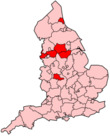
Merseyside South Yorkshire Tyne and Wear West Midlands West Yorkshire  25 largest settlements in the UK by urban core population*
25 largest settlements in the UK by urban core population*- London: 7,172,091
- Birmingham: 970,892
- Glasgow: 629,501
- Liverpool: 469,017
- Leeds: 443,247
- Sheffield: 439,866
- Edinburgh: 430,082
- Bristol: 420,556
- Manchester: 394,269
- Leicester: 330,574
- Coventry: 303,475
- Kingston-upon-Hull: 301,416
- Bradford: 293,717
- Cardiff: 292,150
- Belfast: 276,459
- Stoke-on-Trent: 259,252
- Wolverhampton: 251,462
- Nottingham: 249,584
- Plymouth: 243,795
- Southampton: 234,224
- Reading: 232,662
- Derby: 229,407
- Dudley: 194,619
- Newcastle upon Tyne: 189,863
- Northampton: 189,474
*Based on 2001 Census data.European Capitals of Culture 1985 Athens · 1986 Florence · 1987 Amsterdam · 1988 West Berlin · 1989 Paris · 1990 Glasgow · 1991 Dublin · 1992 Madrid · 1993 Antwerp · 1994 Lisbon · 1995 Luxembourg City · 1996 Copenhagen · 1997 Thessaloniki · London 1998 Stockholm · 1999 Weimar · 2000 Reykjavík · Bergen · Helsinki · Brussels · Prague · Kraków · Santiago de Compostela · Avignon · Bologna · 2001 Rotterdam · Porto · 2002 Bruges · Salamanca · 2003 Graz · 2004 Genoa · Lille · 2005 Cork · 2006 Patras · 2007 Luxembourg City and Greater Region · Sibiu · 2008 Liverpool · Stavanger · 2009 Linz · Vilnius · 2010 Essen · Istanbul · Pécs · 2011 Turku · Tallinn · 2012 Maribor · Guimarães · 2013 Košice · Marseille · 2014 Umeå · Riga · 2015 Mons · Plzeň · 2016 San Sebastián · Wrocław
Buildings and structures in Liverpool, England Skyscrapers and highrises
(over 60m)1 Princes Dock · Alexandra Tower · Beetham Tower · Mann Island Buildings · Municipal Buildings · New Hall Place · One Park West · The Plaza · Port of Liverpool Building · Post & Echo Building · Radio City Tower · Royal Liver Building · Thistle Atlantic Tower · Unity Commercial · Unity Residential · West Tower
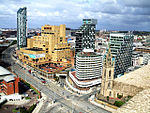
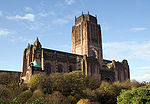

Notable lowrises Albert Dock · Alder Hey Children's Hospital · Bank of England · Bluecoat Chambers · Britannia Adelphi Hotel · Chinese Arch · County Sessions House · Crowne Plaza LJLA · Cunard Building · Empire Theatre · Everyman Theatre · Grand Central Hall · Great North Western Hotel · Hargreaves Building · Hilton Liverpool · India Buildings · International Slavery Museum · Liverpool Central Library · Liverpool Cotton Exchange Building · Liverpool Magistrates' Court · Liverpool Playhouse · Liverpool Town Hall · Liverpool Women's Hospital · The Lyceum · Malmaison · Merseyside Maritime Museum · Museum of Liverpool · National Conservation Centre · Oratory · Oriel Chambers · Philharmonic Hall · Prudential Assurance Building · Queen Elizabeth II Law Courts · Royal Court Theatre · Royal Insurance Building · Royal Liverpool University Hospital · Speke Hall · Stanley Dock Tobacco Warehouse · St. George's Hall · Tate Liverpool · Tower Buildings · Victoria Building · Walker Art Gallery · White Star Building · World Museum Liverpool
Places of worship All Saints' Church · Al-Rahma Mosque · Church of All Hallows · Church of St Agnes and St Pancras · German Church · Greek Orthodox Church of St Nicholas · Gustav Adolfus Kyrka · Liverpool Cathedral · Liverpool Metropolitan Cathedral · Norwegian Fishermans' Church · Old Christ Church · The Oratory · Princes Road Synagogue · St George's Church · Saint John the Baptist's Church · St Luke's Church · St Luke's Church, Walton · St Michael's Church · Toxteth Unitarian Chapel · Unitarian Chapel · Welsh Presbyterian Church
Transportation Shopping complexes Sports venues and arenas Anfield · Echo Arena · Goodison Park · Liverpool Cricket Club · O2 Academy Liverpool · Wavertree Athletics Centre
Sculptures and monuments Nelson Monument · Steble Fountain · Superlambanana · Titanic Memorial · Wellington's Column
Lists Categories:- Liverpool
- 1207 establishments
- Cities in North West England
- European Capitals of Culture
- Metropolitan boroughs
- Populated coastal places in Merseyside
- Populated places established in the 13th century
- Port cities and towns in the United Kingdom
- Towns in Merseyside
- World Heritage Sites in England
- Local government districts of North West England
- NUTS 3 statistical regions of the United Kingdom
Wikimedia Foundation. 2010.


